Since I was a young child Mars held a special fascination for me. It was so close and yet so faraway. I have never doubted that it once had advanced life and still has remnants of that life now. I am a dedicated member of the Mars Society,Norcal Mars Society National Space Society, Planetary Society, And the SETI Institute. I am a supporter of Explore Mars, Inc. I'm a great admirer of Elon Musk and SpaceX. I have a strong feeling that Space X will send a human to Mars first.
Sunday, December 31, 2023
Saturday, December 30, 2023
Thursday, December 28, 2023
Wednesday, December 27, 2023
Sunday, December 24, 2023
Saturday, December 23, 2023
Friday, December 22, 2023
Thursday, December 21, 2023
Soviet and U.S. Manned Military Space Programs That Never Left The Ground
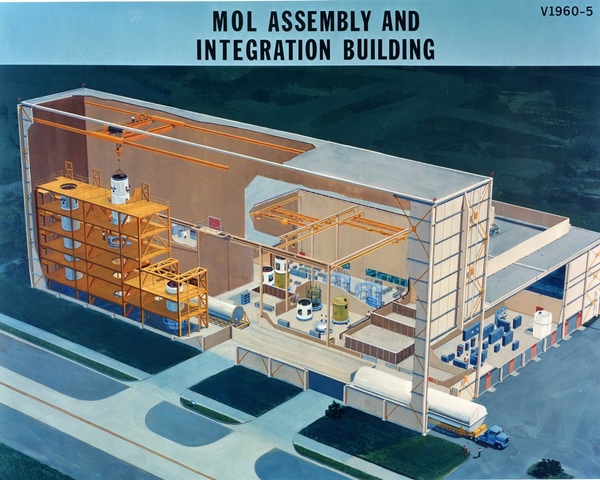 The Douglas building where MOL would undergo final assembly prior to shipment to Vandenberg Air Force Base. (credit: NRO) |
Diamonds and DORIANS: The Soviet Union’s Almaz and the United States’ Manned Orbiting Laboratory military space stations (part 2)
MOL and Almaz enter active development
by Dwayne A. Day and Bart Hendrickx
Monday, December 18, 2023
The American story
The Manned Orbiting Laboratory was initially started by the US Air Force in late 1963, studied throughout 1964, and received presidential authorization by summer 1965. Contract definition, proposal evaluations, and contract negotiations occurred thru late 1966, but by early 1967 it was clear that there was insufficient budget to proceed on the planned schedule and timeline and contract adjustments followed (see “Diamonds and DORIANS: the Soviet Union’s Almaz and the United States’ Manned Orbiting Laboratory military space stations (part 1),” The Space Review, December 11, 2023.) By mid-1967, the program was well underway, with various contractors around the United States building facilities and ramping up work. MOL, and its huge KH-10 DORIAN optical system, became a major military space program for the United States Air Force and the secretive National Reconnaissance Office (NRO).
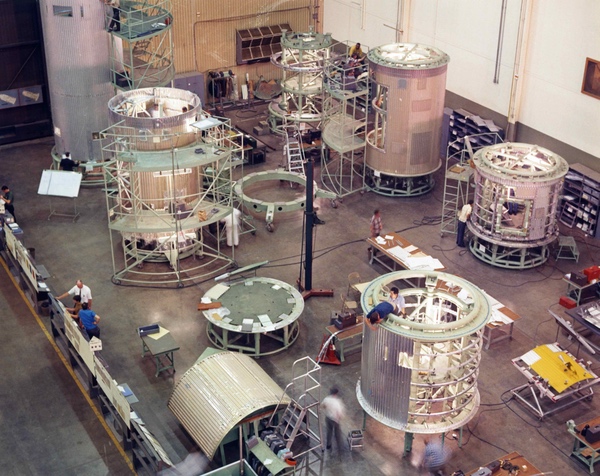 The MOL laboratory was a large vehicle with many components. (credit: NRO) |
Station design
MOL consisted of a Gemini spacecraft, a connecting section, a pressurized operations section known as the “laboratory module,” and a large unpressurized segment known as the “mission module” containing the optics. The Gemini was officially known as the Gemini B. It was similar to the NASA Gemini spacecraft with one significant difference: an access hatch located between the astronauts’ seats and passing through the heat shield. This was considered a potential vulnerability. In November 1966, the Air Force launched a Titan III rocket carrying a refurbished Gemini spacecraft equipped with the heat shield hatch. The rocket launched from Florida and the spacecraft flew a suborbital trajectory and splashed down in the Atlantic Ocean, proving that the heat shield worked.
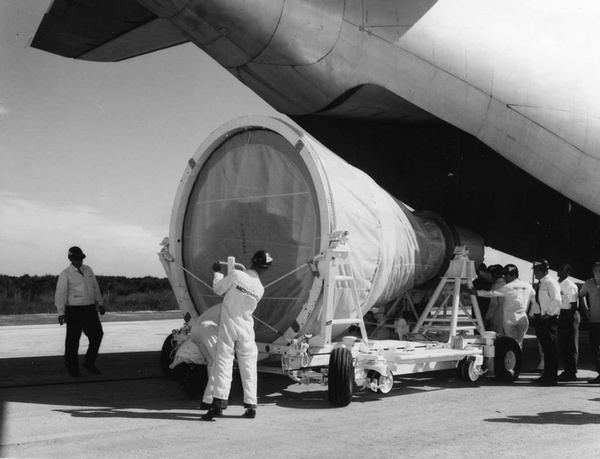 The Gemini B spacecraft had a hatch through the heatshield to enable the astronauts to reach the laboratory module. In November 1966, the Air Force launched a test version of the spacecraft to evaluate the hatch. Here the spacecraft is being unloaded in Florida. (credit: Joe Page II) |
MOL was a heavy payload and required a powerful rocket to reach orbit. The Titan IIIC rocket had added solid rocket motors to the side of a Titan II core stage. It had its first flight in summer 1965. MOL required even more lifting capability, provided by bigger solid rocket motors consisting of seven motor segments. This rocket was designated the Titan IIIM. Testing was not scheduled until 1969.
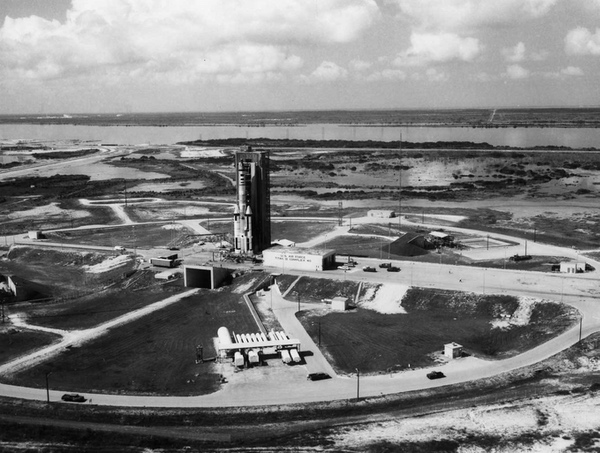 The unmanned Gemini test flight was conducted from Florida using a Titan IIIC rocket. Actual MOL launches would take place in California using a more powerful rocket known as the Titan IIIM. (credit: Joe Page II) |
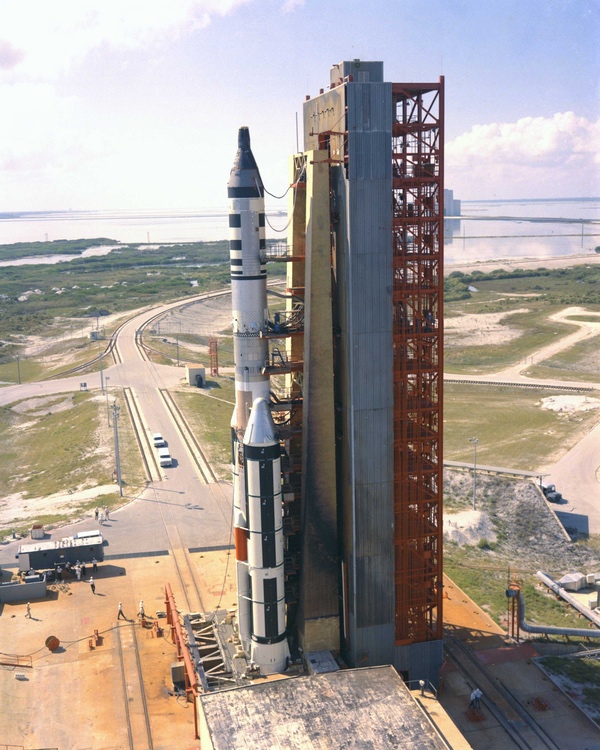 The Titan IIIC being prepared for flight. The test was successful, proving that the heatshield hatch was safe. (credit: Wikipedia) |
Throughout 1967 and 1968, work progressed on a major construction project at Vandenberg Air Force Base to provide a launch site for the Titan IIIM and support to the payload, including the Gemini spacecraft. Vandenberg had been busy in the late 1950s and through the 1960s for the test-launching of ballistic missiles, and launched operational intelligence satellites on a near-weekly basis, but it had never supported a mission with astronauts. The construction at Space Launch Complex 6 (or “Slick-6”) took place at a southern part of the base on newly-acquired land, and it was one of the largest single construction projects the base had ever seen. After the clearing of land and the establishment of the concrete foundations for the complex, workers began erecting the launch tower and related structures.
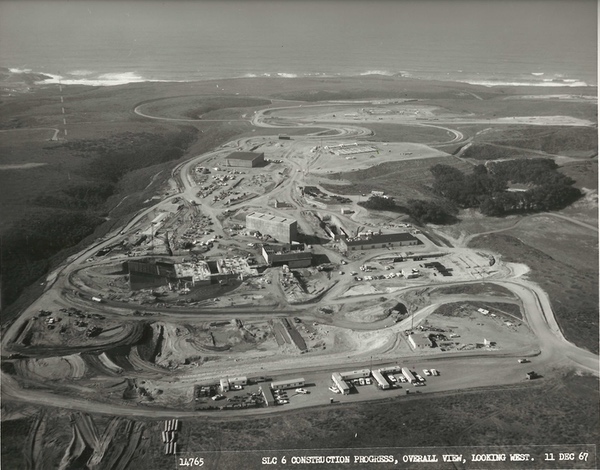 The Space Launch Complex 6 construction site was one of the largest projects at Vandenberg Air Force Base. (credit: Joe Page II) |
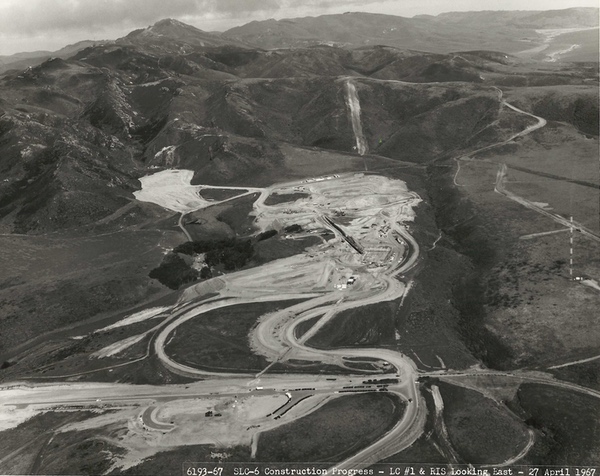 SLC-6 at Vandenberg is nestled between low rising mountains and the Pacific Ocean. The site has recently been turned over to SpaceX and will likely resume launches in 2025. (credit: Joe Page II) |
The DORIAN optical payload
The Manned Orbiting Laboratory program included a powerful optical system code-named DORIAN, also known as the KH-10 to those who were not cleared to know the specific design features of the hardware. The optical system was mounted in what was known as the “mission module” located behind the “laboratory module.” The mission module was 11 meters (36 feet) long and three meters (ten feet) in diameter. DORIAN was the largest space optics system designed up to that time. It used the same general configuration as the GAMBIT satellite, which had an optical system designed by Kodak. It had a “tracking mirror” on one end—near the middle of the MOL vehicle—which bent the light and sent it to a primary, large focusing mirror at the rear of the spacecraft. The primary mirror then sent the focused image back to a secondary mirror located in front of the tracking mirror. This secondary mirror bent the image up to another mirror that then sent the image into the camera, where the image was projected onto a piece of film.
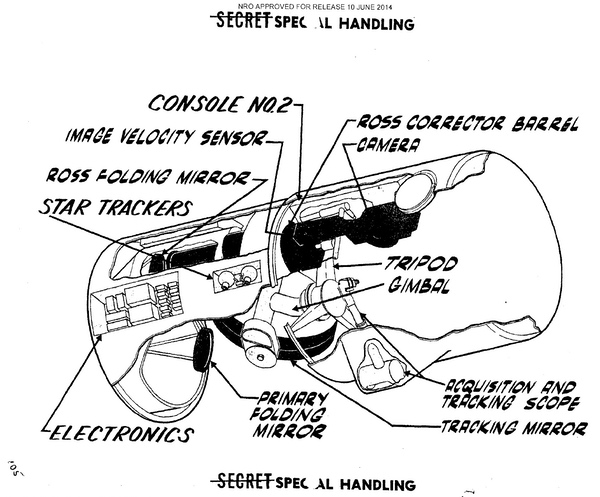 A portion of the DORIAN optical system including the large ”tracking mirror” (also referred to as the “stereo mirror”) which looked down towards the Earth. The astronauts would have been located to the right in this image. (credit: NRO) |
The primary mirror had a diameter of 1.8 meters (72 inches). The focal length remains classified, but based upon declassified drawings that include the dimensions of the mission module, it appears to have been 12.45 meters (490 inches) and f/7, which was the ratio of the aperture to the focal length. (Generally, the lower the f-ratio, the more light reaches the focal point where the film is exposed—like the difference between looking down a short, wide tunnel compared to a long, narrow tunnel, which will naturally be darker.)
The DORIAN system was intended to achieve ten-centimeter (four-inch) ground resolution from orbit. This was referred to as a “very high resolution” or VHR system. (By the 1970s, the term was apparently changed to ultra-high resolution.) The purpose of such high resolution was to provide technical details of certain Soviet weapons systems. For instance, a VHR system could determine the aerodynamic flight surfaces on a Soviet anti-ballistic missile, thus indicating if it was intended to operate in the atmosphere or above it.
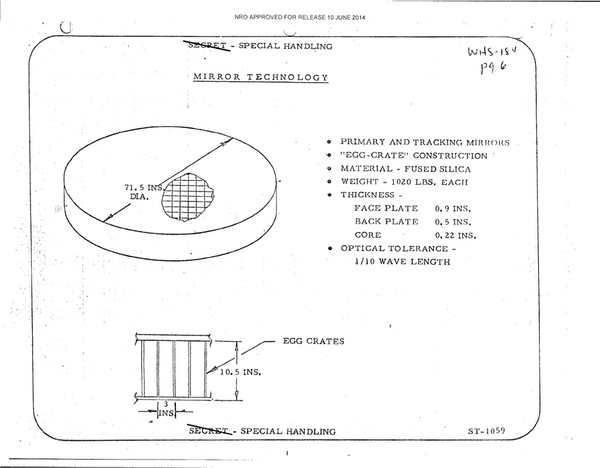 MOL would have used the largest optical system ever flown in space. The mirror was of an advanced lightweight design, and the technology was later adapted to the KH-11 KENNEN and the Hubble Space Telescope. (credit: NRO) |
The big primary reconnaissance camera was augmented with additional optical systems. Robotic spacecraft included cameras that photographed the Earth’s horizon, which provided precise data on how the spacecraft was oriented—for instance, was it pointed straight down or off to one side? They also had stellar cameras that looked up and photographed the stars, providing location data. They often had “terrain” or mapping cameras that took wider field of view images to enable photo-interpreters to look at a big picture image and then compare the reconnaissance photos to know precisely where they were looking.
MOL had some unique requirements. The astronauts needed to see not only what the big optical system was seeing at that moment, but also what potential targets were coming up. MOL therefore had two acquisition optical systems, one per astronaut. The astronauts would work side by side, with their backs towards Earth. Each could peer through their own eyepiece that showed the terrain coming up ahead, as well as through another eyepiece that showed what the KH-10 optical system was looking at at that precise moment. The KH-10 had a primary and secondary eyepiece so that each astronaut could see the powerful view of the ground, good enough to see people walking on a city street.
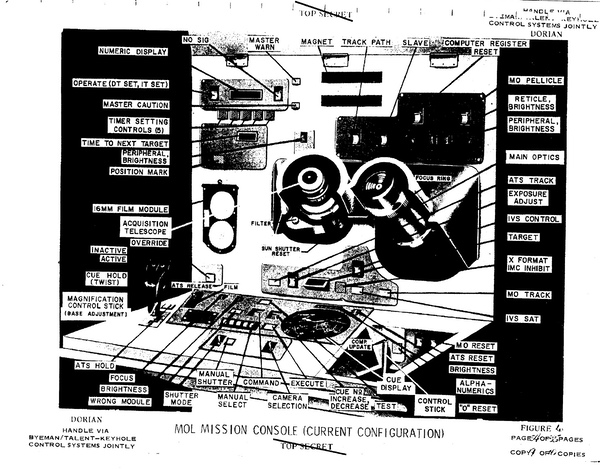 The MOL mission console was connected to a powerful computer—by 1960s standards—that included a pre-loaded target set and allowed the astronauts to prioritize which targets to photograph based upon atmospheric conditions such as clouds as well as intelligence value. For example, photographing a Soviet missile on its launch pad was a high priority. (credit: NRO) |
The astronauts’ job during a photographic pass over a target area was to view the upcoming targets and then prioritize them based upon such factors as visibility (i.e. haze or cloud cover) and interest. They would quickly enter this data into an onboard computer that controlled the pointing of the DORIAN optical system. The computer already had a target database, and the astronauts updated that database in real time. In certain target-rich environments like Moscow, not all targets could be photographed before the spacecraft moved out of view, so this real-time prioritization was valuable. For instance, if while flying over the sprawling Baikonur launch facility in Kazakhstan, the astronauts could decide on which specific launch pads to photograph based upon whether there was a rocket on the pad, or if it was obscured by clouds.
Because MOL was an unusual program with both unclassified and classified elements, many details about it were released while it was under development, although this conveniently helped to obscure and distort what MOL was actually intended to do. For example, the public impression of MOL was that it was a large pressurized compartment and many experiments, rather than a small pressurized compartment and an operational reconnaissance mission.
Based upon the unclassified parts alone, it was clear that MOL was a complex and expensive project. In 1967 the Air Force awarded fixed-price incentive-fee contracts to Douglas Aircraft for $674.7 million and McDonnell for over $180 million. Douglas was responsible for the laboratory module’s unpressurized and pressurized sections and McDonnell for the Gemini B spacecraft. Other sources indicate that McDonnell was supposed to provide four Gemini B spacecraft with options for two or more later. Douglas signed subcontracts for such components as the waste management system, attitude control, and life support. When Douglas and McDonnell merged later that year, the combined company was responsible for a very large Department of Defense space contract.
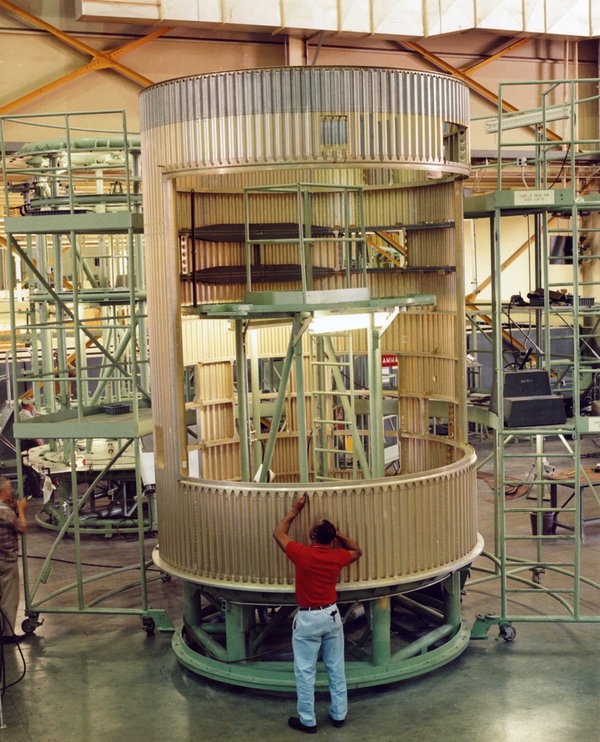 The MOL laboratory had the same diameter as the Titan IIIM launch vehicle. Although the pressurized laboratory was small by today's standards, it was the largest human spacecraft under development before Skylab. (credit: NRO) |
Because the astronauts were supposed to live inside MOL for a month-long mission, this drove the requirement to include life support equipment that had not been necessary for Mercury or Gemini. The spacecraft was to be equipped with more food options, as well as a toilet. These were new system developments.
| The public impression of MOL was that it was a large pressurized compartment and many experiments, rather than a small pressurized compartment and an operational reconnaissance mission. |
General Electric also received a contract for $110 million for “experiment integration work,” which included aspects of the highly-classified KH-10 DORIAN optics system. However, Eastman Kodak, which had manufactured both the GAMBIT-1 (KH-7) and GAMBIT-3 (KH-8) camera systems, also was contracted to build the similar but much larger KH-10 system, although the contract amount remains classified. For other robotic reconnaissance programs, the camera system was the largest expense (the KH-9 HEXAGON camera system accounted for over half of the program’s total budget), so the DORIAN system would not have been cheap. MOL, though, had the additional expense of all the systems, including the Gemini spacecraft, needed to support the astronauts. At its peak, Kodak had over 1,000 direct and indirect workers on DORIAN.
One illustration indicates that both General Electric and Eastman Kodak built electronics for controlling the camera system. GE’s work was apparently associated with controlling the large rotating, image reflecting mirror for the DORIAN camera system. This mirror not only tracked the moving ground target but also enabled the camera to take a photograph of the ground from one angle. Then, as the spacecraft traveled over it, the mirror could rotate to a new position and enable the camera to view the ground target from another angle. This stereo photography made it possible to take accurate measurements of objects on the ground.
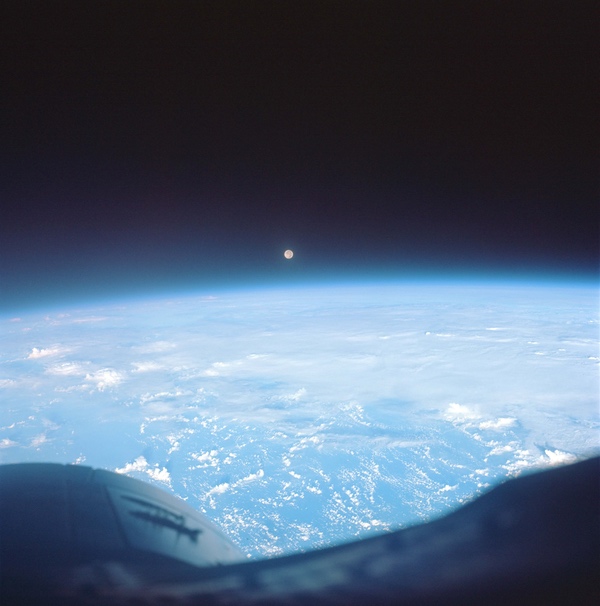 The view from the Gemini 7 spacecraft. Whereas NASA's Gemini missions were used to test equipment, procedures, operations, and people, the Gemini B for MOL was primarily a way for the astronauts to reach and return from space, and the spacecraft would have been unoccupied during the 30-day mission. (credit: NASA) |
Returning MOL images to Earth
Technical intelligence did not have to be timely intelligence. Analysts determining the range of a ballistic missile could make their assessments over time and did not have to do so immediately. But MOL’s 30-day mission was a long time to wait for such expensive photographs, and from the beginning of the program, managers sought methods of returning some of the imagery to Earth before the mission was over.
The DORIAN camera exposed wide-format film that was located inside the pressurized laboratory module. The astronauts could remove the film from the camera. There were three options for returning the imagery to Earth. The first was to store the film inside the Gemini spacecraft in one of three locations established for that purpose. The amount of film that could be carried in the Gemini was limited by mass, but probably also by volume.
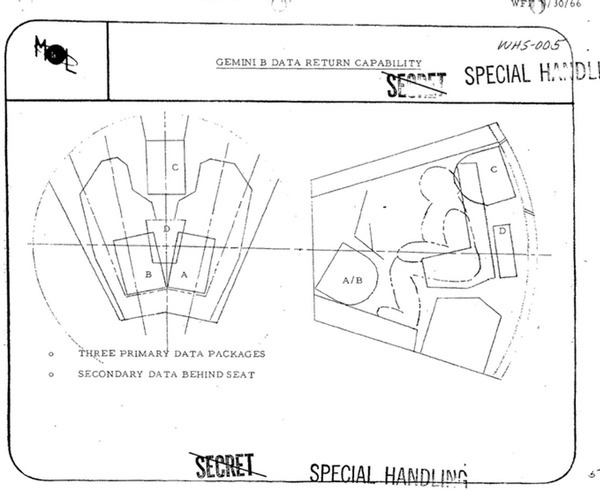 There was only limited room in the Gemini B spacecraft for storing the high-resolution photographs taken during flight. (credit: NRO) |
The second option was to place the film in a reentry vehicle that could then be jettisoned and returned to Earth. This “data return vehicle” was based upon the proven design used for the CORONA and GAMBIT reconnaissance satellites. According to one document, designers considered including up to two of these return vehicles in the MOL. The reentry vehicle could carry 27 kilograms (60 pounds) of film, and the Gemini could return 109 kilograms (240 pounds).
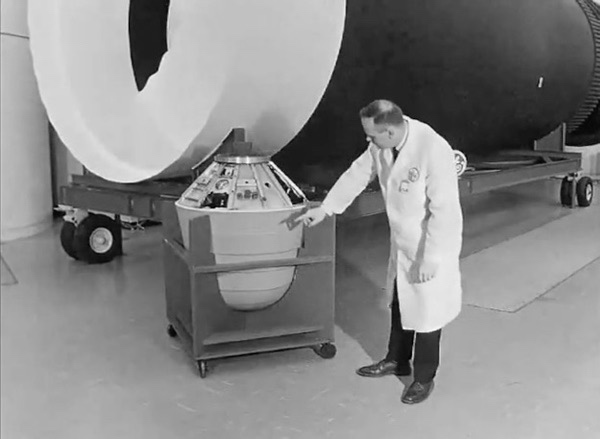 Another method for returning MOL film to Earth was to pack it inside a reentry vehicle like the one shown here in front of the full-size MOL spacecraft. The Air Force was concerned about putting the reentry vehicle, with its retro rocket and other pyro systems, inside the pressurized spacecraft. (credit: NRO) |
The third option was initially proposed in 1964, but was apparently only included in the baseline MOL vehicle later, possibly by early 1966. That involved developing the film in orbit and scanning it using a laser scanning device that converted the light and dark parts of the film into electrical impulses that could then be transmitted via radio to the ground. By March 1966, Eastman Kodak and General Electric had been contracted to conduct preliminary studies of the performance and the detailed design of a readout system, but program officials concluded that the contractors were not progressing fast enough.
Film-scanning technology had been developed decades earlier for the newspaper industry to enable photographs to be transmitted over telephone lines, and it had been incorporated into the Air Force’s first reconnaissance satellite, Samos. It was later adapted for use by NASA in the Lunar Orbiter program. The available bandwidth limited how many images could be sent to the ground: the MOL astronauts would select only the most important photographs for transmission. The system could be useful for crisis reconnaissance, but its inclusion in the spacecraft was not assured.
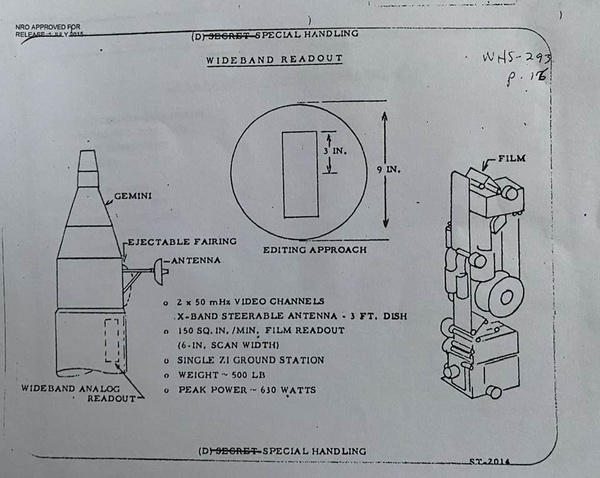 A film readout system was proposed for MOL enabling the astronauts to send images to Earth much more quickly than using the Gemini spacecraft. It was eliminated from the MOL due to the need to cut costs. (credit: NRO) |
Starting around 1965 and continuing through 1966, work had been underway to develop a readout version of the GAMBIT-3 reconnaissance satellite known as FROG. CBS Laboratories was developing a test system to work with the GAMBIT-3 optics. But late in 1966 that work was ordered to be discontinued by February 1967 because the NRO’s Executive Committee concluded that the FROG system could not be afforded and was unnecessary considering the other reconnaissance systems in use by the United States. The NRO Director did make the technology available to the Air Force for possible use in reconnaissance aircraft such as the RF-4C Phantom. Although this never transpired, it was used for a ground-based system for scanning and transmitting aerial reconnaissance photos.
The CBS Laboratories readout system being developed for FROG, along with plans for the ground processing system, became part of the baseline for the MOL, replacing earlier systems being studied by Kodak and General Electric (see “FROG: The Film Read Out GAMBIT program,” The Space Review, February 7, 2022.)
Both the film-readout system and the film-return system were included in the baseline MOL design, although there was increasing uncertainty about whether both were necessary. In November 1966, an internal NRO evaluation concluded that CBS Laboratories had made considerable progress at developing a readout transmission system. More work remained to be done, but the technology was maturing rapidly.
| By February 1967, the MOL program came under major budget pressure. After carefully negotiating contracts with multiple contractors, it became clear that the program would not have enough budget to fund them. |
The DORIAN camera used 23-centimeter-wide film. Each 23-centimeter (9-inch) diameter image on the film had a ground diameter of 2,743 meters (9,000 feet). The readout system was not equipped to transmit an entire frame from the DORIAN camera. Rather, the astronauts would examine the developed film in orbit using a microscope, and then cut out the most important part of the image. This “chip” would then be scanned for transmission to the ground. The system capability was to be up to 160 frame “chips” per day of 5 x 15-centimeter (2 x 6-inch) film-readout, roughly equivalent to 610 by 1,828 meters (2,000 by 6,000 feet) on the ground. A 30-day MOL mission could produce up to 5,364 meters of exposed film, although the amount that would be transmitted to the ground would be relatively small (see “Live, from orbit: the Manned Orbiting Laboratory’s top-secret film-readout system,” The Space Review, September 18, 2023.)
For the surveillance mission the system would provide for target reprogramming, camera performance analysis, and provide time-urgent reconnaissance information. For a technical intelligence mission, it would provide for target reprogramming and camera performance analysis. Compared to the data return vehicle, it could provide daily data return versus only once or twice for the return vehicle, although it is not clear how much crew time this would require.
One of the requirements for the film-readout system was to transmit the maximum resolution of the photography. Because DORIAN was intended to produce ten-centimeter (four-inch) resolution images, the readout system had to be able to transmit ten-centimeter resolution images. This was necessary for evaluating camera performance.
By February 1967, the MOL program came under major budget pressure. After carefully negotiating contracts with multiple contractors, it became clear that the program would not have enough budget to fund them. The MOL program leadership determined that the contract schedules would have to be renegotiated in order to stay within the available budget line. This also put pressure on management to eliminate systems that were not considered essential to the MOL mission such as the readout and data return vehicle systems.
In addition, Eastman Kodak had encountered a problem with the DORIAN system’s fused silica optical components, which due to thermal issues would likely not be capable of achieving the system’s resolution goal for the first two missions. This too may have increased pressure to cancel non-essential equipment.
There were, however, arguments in favor of keeping readout. MOL management was feeling pressure to justify having astronauts on MOL. The readout system was designed to be operated by astronauts, and there was no way that an automatic MOL could select which images to scan and transmit to the ground, or could transmit the massive amount of data in a full-size MOL image.
The MOL program managers increasingly favored the readout system over the data return vehicle. The data return vehicle had a retrorocket and pyrotechnics that posed a risk to the crew, something that became a bigger concern after the January 1967 Apollo 1 fire.
In March 1967, Major General Harry Evans, the deputy director for the MOL program, recommended to the NRO Director that the readout system for MOL be continued and the data recovery capsule be eliminated. Evans argued that the safety and engineering problems of the capsule were serious. He also stated the readout system was superior to the capsule. However, most of his justifications for including the readout system were for engineering testing purposes rather than due to its value as an operational intelligence collection system.
On March 20, Colonel Lee Battle wrote a cable to NRO Director Alexander Flax stating that he had decided to cancel the data recovery vehicle and continue the readout system. However, for reasons that are not completely clear based upon available records, Flax did not approve this decision. According to an April 1967 status report, both the readout system and data return vehicle were deleted from the baseline MOL development program. The mass and volume requirements for both systems were still included in the MOL baseline design in the event that the systems were added back to the vehicle.
According to one source, the readout system was canceled in fall 1967, but it may have had sufficient contract funding to carry it a few months beyond April 1968. A General Electric engineer who worked on the reentry vehicle system indicated that it was always on the verge of cancellation, but did not get canceled before the end of the program. It is possible that it, too, may have continued at a low level of effort using existing funds. Eliminating the reentry vehicle meant that the total film returned would have been limited by the amount that could be carried in the Gemini, even if more could have been carried to orbit.
| Without readout, the mission data was unavailable until the end of the mission, and extending it from 30 days to 45 days increased the delay until people on the ground could see the photographs. |
In October 1968, General Electric began study of a “poor man’s” wide-band readout system. The new study sought to determine if the data could be relayed through an IDCSP or DCS Phase II communications satellite—the former was already in operation and the latter was scheduled for launch in the early 1970s. Using a relay satellite would dramatically increase the time available to transmit the imagery, from only 500 seconds per day using a single ground station to more than 38,000 seconds per day using a satellite in geostationary orbit. More transmission time meant more imagery could be transmitted, although it is unclear how adding this relay capability would have lowered costs.
General Electric provided a report on the capabilities of a readout system by December 1968. The project had often been abbreviated as “R/O” in previous years, and the program decided that in unclassified communications the system would be referred to by the Greek letter “Rho,” although a clever KGB officer might have been able to make the connection.
By May 1969, the plan was to fly four manned MOL vehicles: in July 1972, January and July 1973, and January 1974. If MOL was continued to a Phase II, or Block II configuration, flights could continue on this schedule through January 1976. The Block II MOL could have enhanced capabilities including infrared and multispectral sensors, ultraviolet astronomy, and scene recording and transmission from the tracking scope and the main optics. The mission duration could be extended from the baseline 30 days to a 45-day mission.
One possible upgrade was adding the deleted film-readout capability. The May 1969 report on the Block II vehicle listed several new missions that could be enabled by the availability of readout. These included crisis management, event warning (including missile tests, launch site or downrange activity, satellite launches, nuclear testing, and ABM site activity), targets of opportunity, and request support. As the report noted, without readout, the mission data was unavailable until the end of the mission, and extending it from 30 days to 45 days increased the delay until people on the ground could see the photographs. For the technical intelligence mission this was not a problem, but for event warning and crisis management, the photographs could be useless by the time they reached the ground.
Other payloads
Although DORIAN was the primary intelligence payload for the MOL, in 1965 and 1966 other intelligence payloads were also considered and under development.
By February 1965 there had been a proposal for a communications intelligence (“COMINT”) payload to intercept signals from a Soviet microwave communications system serving both civil and military users. The identity of the target system remains classified, but it apparently consisted of a network of transmitters throughout the Soviet Union. The program manager in the MOL office, Colonel John Copley, determined that intercepting the transmitters’ narrow main beams would be difficult, but that collecting from their sidelobes, which radiated out at much lower power from a transmitter’s sides like the feathers on a peacock, would increase intercept times while a satellite was overhead. In the best case, it could gather up enough information to determine what was being transmitted over the network, at least while the MOL was overhead.
Copley proposed that this signals intelligence collector should be included on MOL. It would use a two-meter (six-foot) diameter parabolic “wrapped rib” antenna that would unfold from the side of the big cylindrical MOL. Unlike an umbrella-type dish, the antenna wrapped flexible ribs and the mesh antenna strung between them around a central spoke, enabling a larger diameter antenna to be packed in a smaller volume.
E-Systems in Garland, Texas, and EDL-Sylvania developed a test system. An Air Force helicopter flew a payload in an intercept pattern through the main beam and sidelobes of a microwave antenna at the E-Systems facility outside Dallas. EDL analysts examined the collected data and made recommendations for a mission. The payload activities were handled within the BYEMAN security control system under a unique management arrangement.
| Simply getting MOL funded was proving to be a major struggle for the program throughout 1967 and 1968. |
Sometime in 1965, with the MOL getting increasingly complicated, MOL program managers decided to eliminate the communications intelligence payload from the spacecraft. Although the details are somewhat murky about exactly when this happened, in November 1965 the SIGINT Working Group of the Committee on Overhead Reconnaissance, which established targets and prioritization requirements for US signals intelligence satellites, determined that the information transferred over the Soviet communications network had “high intelligence value.” In a document, the group declared that a system was required “to obtain sufficient technical data concerning the location, antenna patterns, and modulation of the [deleted] system to permit valid consideration of [a] follow-on collection system.” The group also indicated that this data could be useful for a planned geosynchronous signals intelligence collection system whose name was deleted from the document, but was almost certainly the CANYON communications intelligence satellite then being built by Lockheed and eventually launched in 1968.
With the payload no longer part of the MOL program, National Reconnaissance Office officials soon transferred the project to the program office in Los Angeles that operated the NRO’s growing stable of SIGINT satellites. At some point the payload was named DONKEY. It is unclear when or why the payload received this name, although it clearly had this code-name by early 1966 (see “The wizard war in orbit, part 3,” The Space Review, July 5, 2016, and “Applied witchcraft: American communications intelligence satellites during the 1960s,” October 19, 2020.)
Another system that was under development in 1965 and 1966 was a radar for the Navy that could be mounted on MOL. By fall 1966, responsibility for the sensor was transferred to the NRO, where it was apparently given low priority and deleted from the MOL program. The Navy, unhappy with its treatment by the NRO, sought to develop the sensor on its own, but ran into bureaucratic headwinds. The Navy radar was apparently no longer part of MOL by 1967 (see “Blacker than blue: the US Navy and the Manned Orbiting Laboratory,” The Space Review, October 21, 2019.)
Available records indicate that for the majority of its existence, MOL was intended to carry the DORIAN optical system and no other payloads. Simply getting MOL funded was proving to be a major struggle for the program throughout 1967 and 1968.
The Soviet story
Station design
The earliest plans for Almaz envisaged a concept very similar to MOL. The three-man crew would be launched in a return vehicle (VA) attached to the station for missions lasting one to three months, after which the station would be abandoned. Only at a later stage would crews and cargo be delivered to the station in transport vehicles, making it possible to make multiple visits to the station and increase the lifetime to about one year. Advantages of the so-called “autonomous station” were that it would become operational right after reaching orbit instead of having to wait for a crew to arrive. This mission profile also eliminated the risk of losing the station in case the transport ship suffered a launch accident or failed to dock with the station. It should not be forgotten that in the mid-1960s the Soviet Union did not have any experience whatsoever with space rendezvous and docking. The return capsule ensured the safety of the crew throughout the flight. In the event of a launch failure, it could be ejected from the station with a launch escape tower and, in case of an emergency in orbit, it could serve as a rescue vehicle.
The design of the VA return capsule was partially based on that of a piloted circumlunar vehicle (LK-1) that Vladimir Chelomei’s OKB-52 bureau had been working on since August 1964 until that project was transferred to the Korolev bureau about a year later and transformed into L-1 (later officially named Zond.) Aerodynamically, the LK-1 was something of a cross between Gemini and Apollo, and one of Chelomei’s designers later admitted that his team had thoroughly studied the openly available technical literature on those American capsules. Like MOL’s Gemini B, the VA would have had a hatch in its heat shield to allow the crew to transfer to the station. Unlike Gemini B, it was designed to be re-usable for up to ten missions.
 The originally planned version of Almaz with the VA return capsule. (credit: Stolichnaya Entsiklopediya publishers) |
As for the station itself, designers initially looked at the possibility of constructing a long cylinder with a diameter of 4.1 meters, a limit dictated by the fact that the station had to be transported to the Baikonur cosmodrome by rail. However, thеre were fears that this design would make the launch vehicle unstable, and as a result of which it was decided to adopt a tapered design in which the front section of the station had a diameter of just 2.9 meters. This gave it more or less the same shape as the upper composite of the canceled LK-1 circumlunar spacecraft and its Proton launch vehicle, a design that had already undergone extensive wind tunnel tests.
Whereas MOL consisted of an unpressurized section containing the DORIAN telescope and a pressurized section for crew operations, Almaz was essentially one big pressurized structure with a volume of about 90 cubic meters. The main payload (the Agat-1 telescope) was placed vertically inside the 4.1-meter diameter section of the station, looking directly downward to Earth and therefore obviating the need for folding mirrors as in DORIAN. Inside the thinner 2.9-meter section was a workstation to operate the telescope and a living compartment for the crew. At the back of the station was a compartment to install the film return capsules and a small airlock through which the capsules could be ejected from the station.
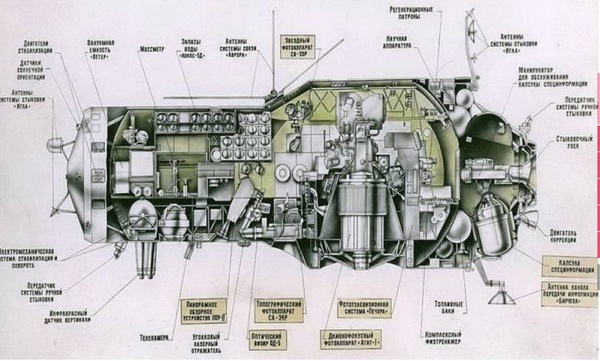 Cut-away drawing of Almaz. (credit: NPO Mashinostroyeniya) |
Transport vehicles
In the end, the concept of the “autonomous station” was dropped entirely. One of its biggest drawbacks was that the presence of the return capsule imposed major restrictions on the amount of equipment that could be installed inside the station. It also reduced mission duration to just a few weeks. Therefore, it was decided to move directly to stage two.
| Whereas MOL consisted of an unpressurized section containing the DORIAN telescope and a pressurized section for crew operations, Almaz was essentially one big pressurized structure with a volume of about 90 cubic meters. |
The first transport ship that was considered for Almaz was a modified version of the 7K-VI/Zvezda vehicle that was being designed by Branch number 3 of Sergei Korolev’s OKB-1 design bureau in Kuibyshev (see part 1.) This was apparently because it had already gained experience with designing a docking mechanism that would allow the crew to move to another vehicle internally as part of the original Soyuz-R proposal that preceded 7K-VI. The “standard” Soyuz then being developed by OKB-1 itself had a crude docking mechanism that made it necessary for cosmonauts to move to a docked vehicle by extravehicular activity, as demonstrated during the Soyuz-4/5 mission in 1969.
Branch number 3 considered to split the crew/cargo transport functions by designing both a crewed and an unmanned cargo version of 7K-VI. However, when the design was evaluated in the spring of 1967, it was concluded that the cargo vehicles would have to be launched about every three weeks to ensure the proper functioning of the station. Also, by this time it had been decided that Almaz would be equipped with film return capsules, which regularly had to be replenished. These capsules were too big to be transferred to the station through the 7K-VI hatch. Consequently, OKB-52 proposed a much larger and much more capable transport vehicle that would double as a crew ferry and cargo truck. Launched by the Proton rocket, it would be about the same size as the station itself and became known as the Transport Supply Ship (TKS).
Serving as the basis for the TKS design was the original, “autonomous” version of Almaz. The station’s hull was shortened and attached to the VA return vehicle. The redesigned hull, which acted as the cargo section, was called the Functional Cargo Block (FGB). Attached to the aft part of the FGB was a conical section with an active docking mechanism. This conical section had the same shape as the bottom section of the Proton rocket’s third stage fuel tank. Since there was not enough room to install the engine system and propellant tanks in the aft of the vehicle (as on Almaz itself), they were placed on the outer hull. Circular fuel tanks would not have fit inside the payload shroud, so they were replaced by eight long, tube-shaped propellant tanks on the circumference of the vehicle. The vehicle’s engines could be used to boost the altitude of the station’s orbit.
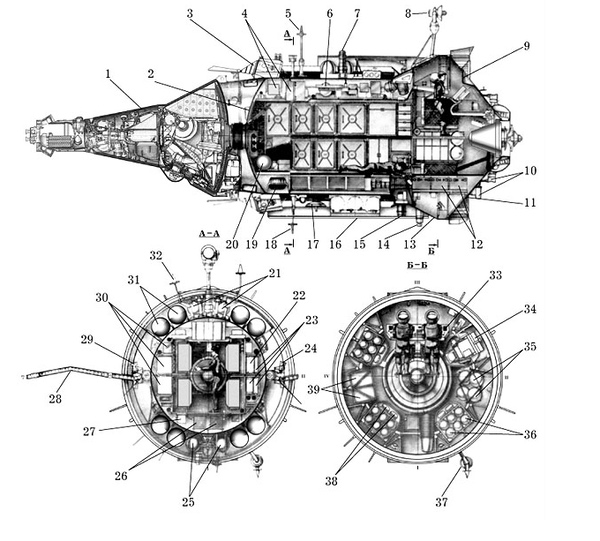 Cut-away drawing of TKS. (credit: NPO Mashinostroyeniya) |
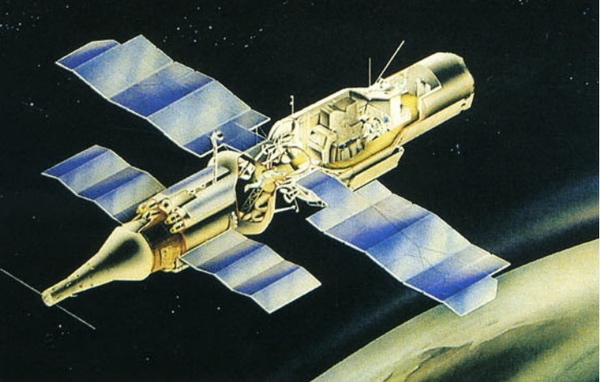 Artist’s conception of TKS docked to Almaz. |
 Docked test models of TKS and Almaz. (credit: NPO Mashinostroyeniya) |
Since TKS was not expected to be ready in time for the first Almaz missions, a decision was made in July 1967 to use Soyuz as an interim transport vehicle. This would be a version derived from OKB-1’s traditional Soyuz vehicle, with the descent capsule in the middle. By the time Almaz flew in the 1970s, the docking mechanism of Soyuz had also been redesigned to enable the crew to transfer to the station internally.
The Agat-1 optical payload
The key goal of Almaz was to obtain detailed imagery in the visible part of the spectrum. The requirement laid out in the July 1966 government decree on Almaz was for the station to return imagery with a ground resolution of 50 centimeters to 1 meter. This was to be achieved with an optical system named Agat (“agate”, a type of quartz), which used a 1.5-meter mirror and had a focal length of ten meters. According to the 2019 Almaz history Ogranka Almazov, the resolution of Agat could actually have been as good as 35 centimeters. However, the design proved to be too complex: among other things, it would have required the telescope to be launched in a folded state and be fully extended through an opening in the hull after reaching orbit. Chelomei’s team reverted to a simpler telescope with an 88-centimeter mirror and a focal length of 6.375 meters. It would use optics that had already been developed for unmanned television reconnaissance satellites that OKB-52 had begun working on in 1963 (see ”Soviet television reconnaissance satellites”, The Space Review, September 5, 2023.) Unlike the Zenit film-return satellites, these satellites would have been able to send back imagery in near real time, but they were canceled later in the 1960s. The simpler camera, still weighing 1.2 tons, was called Agat-1, with the hope being that the originally planned camera would later still fly under the name Agat-2. The prime contractor for Agat-1 was the Krasnogorsk Mechanical Plant (KMZ).
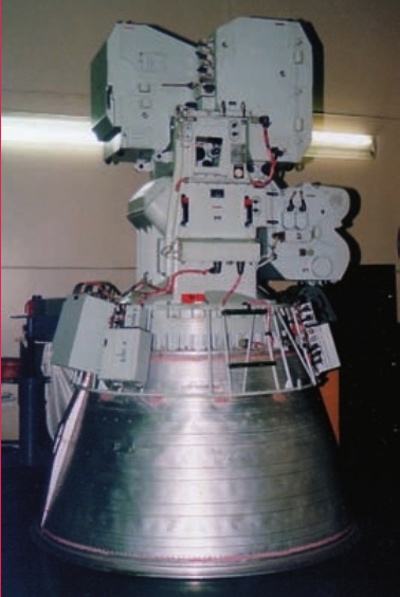 The Agat-1 camera. (credit: NPO Mashinostroyeniya) |
Mounted on top of the telescope were three big film cassettes: two identical ones containing 500 meters of 42-centimeter-wide film and another one containing 500 meters of 53- centimeter film. Several types of fine-grained photographic film, both black-and-white and multispectral, were used, offering a quality not achieved by spy satellites. The exposed 42-centimeter film was sent back to Earth in return capsules for development on the ground and the 53-centimeter film was developed on board the station itself, after which the cosmonauts relayed the more strategically important images to the ground via radio channels.
| Agat-1 was still no match for MOL’s DORIAN telescope with its 1.8-meter mirror and maximum resolution of ten centimeters. |
The cosmonauts played an important role in operating Agat-1. Using two forward-looking optical systems—one wide-angle panoramic system (POU) with a resolution of 30 meters and a narrow-field optical visor (OD-5) with a resolution of one meter—they could look at regions that were well ahead of the station’s flight path, briefly freeze the image with the help of a scanning mirror in the optical visor, and aim the Agat-1 camera at targets of interest. The cosmonauts also recorded their visual impressions of the observed targets on audio tape and communicated them to the ground via secure radio channels. Like MOL’s DORIAN telescope, Agat-1 was to work in conjunction with a topographic camera (SA-34R) and a stellar camera (SA-33R) that took images of the ground and star fields to help determine the exact coordinates of the observed areas.
The authors of the 2019 Almaz history give the maximum resolution of the imagery returned to Earth as one meter and that of the imagery transmitted to the ground as 1.5 meters. Interestingly, they refer to research done by Swedish space historian Sven Grahn, who used optical formulae to calculate that the maximum ground resolution of Agat-1 may have been as good as 43 centimeters. This indicates that they had no access to (probably still classified) data on the actual resolution achieved by the Agat-1 system and that the given values came from documents describing the telescope’s expected performance.
At any rate, Agat-1 was still no match for MOL’s DORIAN telescope with its 1.8-meter mirror and maximum resolution of ten centimeters. That kind of resolution was mainly needed to provide detailed technical intelligence on Soviet weapons systems. Almaz had much broader strategic and tactical objectives, many of which could also be achieved with lower resolution. As can be seen in a declassified diagram published in the 2019 Almaz history, these were:
- to learn more about the functioning and the state of readiness of “strategic objects” such as ICBM launch sites and strategic nuclear weapons
- to pinpoint the location of mobile launch systems
- to identify the types of aircraft, ships, and submarines stationed at air and naval bases
- to determine troop concentrations in the “theater of operations”
- to obtain new information on anti-aircraft, anti-missile and space tracking radars (Agat-1 could contribute to this by determining the shape and geometry of antennas)
- to spot signs of “the heightened readiness of strategic objects” (such as an increase in the number of aircraft at air bases, ships leaving ports etc.)
Returning Almaz images to Earth
Like MOL’s Gemini B vehicle, the transportation systems envisaged for Almaz (the modified 7K-VI, TKS and the standard Soyuz) had a very limited ability to return exposed film back to Earth together with the crew. This is why the bulk of the imagery would have to be delivered to Earth in dedicated film return capsules or relayed to the ground via film readout systems. In contrast to MOL, these were not seen as competitive proposals, but complementary data return techniques.
The data return capsules were officially called “Special Information Capsules” (KSI). Shaped like a thimble, they consisted of a pressurized compartment, a small solid-fuel deorbit engine, and a parachute system. Fully loaded, they weighed roughly 400 kilograms, about 120 kilograms of which was cargo. Most of this was exposed film from the Agat-1 camera, wound in two spools, each of which could carry 500 meters of 42-centimeter-wide film. There was also room for exposed film from the topographic and stellar camera as well as audio tapes recorded by the crew.
 Almaz film return capsule (without heat shield) on display in Moscow. Source |
As noted above, the need to regularly send new film return capsules to the Almaz stations was one of the factors that drove the design of the big TKS transport vehicles. Each TKS was supposed to carry eight return capsules to the station along with its three-man crew. All of these were to be sent back to Earth with exposed film during the three-month missions that were expected to be flown. The capsules could be ejected from the station’s airlock either by a command from the crew or automatically from the ground. In order to ensure that they didn’t accidentally land on foreign territory, they were equipped with a self-destruct system that would be activated in case something went wrong during the return to Earth.
While the film returned by the KSI capsules would need at least several days to reach photo interpreters, the most critical imagery could be returned to Earth almost instantaneously using a film scanning system. Like the United States, the Soviet Union had already tested an experimental film readout system on some of its early automated spy satellites in the early 1960s, but the resolution was so low that it was abandoned. The country continued to rely solely on film-return spy satellites until 1982, when it finally launched its first digital reconnaissance satellite, six years after the US pioneered that technology with its KENNEN satellites.
The film readout system was named Pechora (after a Russian river) and operated very much like the one planned for MOL. The cosmonauts would first cut 1- to 50-meter-long pieces from the exposed 53-centimeter-wide film and then place them in an automatic film development system. After the film was developed, they would inspect it using an optical system named Svet (“light”) and mark the images that were worth transmitting to Earth. These were scanned and turned into television signals that were subsequently beamed to the ground.
Other payloads
Whereas SIGINT and radar payloads were only short-lived proposals for MOL, Almaz was advertised from the outset as a space station that would observe targets in various parts of the electromagnetic spectrum. Radar, infrared, and signals intelligence payloads were to complement the data provided by the Agat-1 telescope.
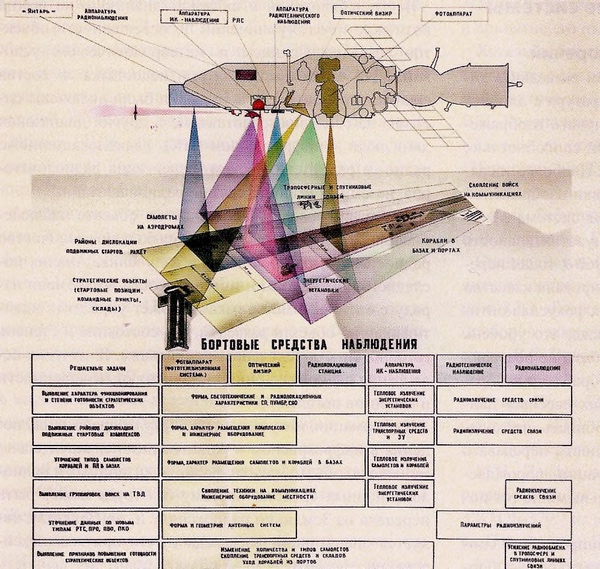 A diagram from the 2019 Almaz history shows the tasks to be carried out by Almaz payloads in various parts of the electromagnetic spectrum. Protruding from the nose of Almaz is the Mech-A radar. (credit: NPO Mashinostroyeniya) |
In the early years of the Space Age, space-based radar observations were of higher priority in the Soviet Union than they were in the United States. After a short test flight of the experimental QUILL satellite in late 1964, the United States military abandoned radar satellites until the 1980s. Several years before the launch of QUILL, Chelomei’s OKB-52 design bureau had begun working on a nuclear-powered radar satellite called US-A (“active controllable satellite”) that saw its first test flights in 1965 and would continue to fly until 1988. The US-A satellites were designed to locate the position of enemy surface vessels in order to provide targeting data for OKB-52’s anti-ship cruise missiles.
| Almaz was supposed to carry an impressive array of equipment to defend itself against anti-satellite attacks. |
The development of the US-A radar system (named Chaika or “seagull”) was in the hands of the Moscow Research Institute of Instrument Building (MNIIP, now the Vega Concern), which was assigned to build a new radar system for Almaz based on the experience it had gained with Chaika. The choice fell on an S-band radar operating at a wavelength of around ten centimeters. This was because S-band radar signals are less susceptible to adverse weather conditions and have a better ability to penetrate foliage and soil than X-band signals. Designated Mech-A (“sword”), the radar consisted of a single 15x1.5-meter antenna attached to the station’s outer hull. The radar images were to be recorded on photographic film and delivered to Earth aboard the film return capsules.
Mech-A was a side-looking radar that could see an area of 100 kilometers either to the left or right of the station’s ground track. This meant that it could not be used to simultaneously observe the same objects photographed by Agat-1, but it was still seen as a vital tool to obtain time-critical imagery of regions that were covered in cloud. Unlike Chaika, which was aimed at ocean reconnaissance, it would be used to fulfill the same tasks as Agat-1, except for the location of mobile launch systems and intelligence of radar systems. Mech-A did suffer from one handicap that still made space-based radar relatively unattractive at the time, namely its low resolution of between 20 and 30 meters.
The infrared payload, called Volga, was provided by the State Institute of Applied Optics (GIPO). It consisted of a 50-centimeter fixed mirror and a rotatable mirror capable of scanning a swath of about 30 kilometers. It operated in the mid-wavelength infrared between 3.2 and 5.2 microns and had a resolution of about 100 meters. Volga was designed to detect the infrared signature of aircraft, ships, and other transportation systems as well as what are defined as “energy installations”. The only mission it could not be used for was intelligence of radar systems. The infrared images would be sent back to Earth in the film return capsules.
Also planned for Almaz was a signals intelligence payload named Start that was to be delivered by NII Vektor. Judging from the declassified diagram in the Almaz book, it would have been used both for electronic and communications intelligence. Aside from pinpointing the location of radars and collecting data on their technical features, the payload would also be able to pick up voice traffic. An increase in such traffic could, for instance, point to preparations for an imminent enemy attack.
In addition to all this, Almaz was supposed to carry an impressive array of equipment to defend itself against anti-satellite attacks (see “Self-defense in space: protecting Russian spacecraft from ASAT attacks”, The Space Review, July 16, 2018.) This included an infrared detector to spot launches of ASAT interceptors, a periscope and a radar to scan the station’s surroundings for incoming interceptors, a radar jamming device, decoys and a rapid-fire cannon (originally developed for 7K-VI), which later was to be replaced by space-to-space missiles with a range of 100 kilometers.
Some of these payloads were scheduled to be introduced only in a later phase of the Almaz project and not all of them would make it into space.
Bart Hendrickx is a longtime observer of the Russian space program. Dwayne Day can be reached at zirconic1@cox.net.
The Space X Starship Will Be A Great Cargo Hauler To The Moon
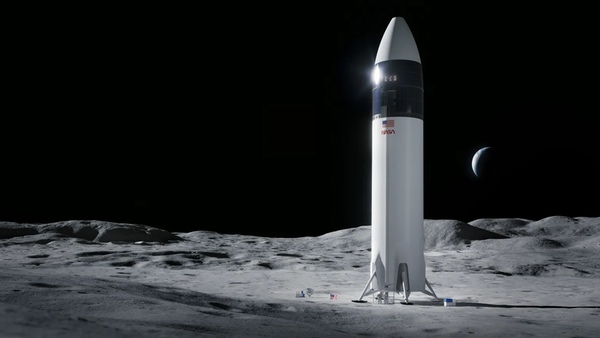 SpaceX’s Starship could be useful not just for transporting cargo to the Moon but also for providing infrastructure. (credit: SpaceX) |
SpaceX Starship in lunar development
by Thomas L. Matula
Monday, December 18, 2023
The November 18 test flight of Elon Musk’s Starship that was launched from Boca Chica on the Texas Gulf Coast suggests the day is ever closer this mega-rocket, in its future iterations, will be available for missions to the Moon. Already selected by NASA for the Human Landing System (HLS) program, the lunar variant of the Starship will open up the Moon to both exploration and industrialization. That said, even SpaceX itself may not yet recognize the extent to which Starship will revolutionize lunar surface operations.
Ever since the 1990s I have been exploring and analyzing business models for lunar economic development and two basic problems have always emerged:
- The inability of launch providers to send cargo to the Moon in the necessary quantities and at a cost economically viable for both exploration and industrialization.
- The challenge of remotely building facilities on the lunar surface.
The lunar variant of the Starship promises to solve such problems as well as others that logically present themselves in any pioneering endeavor.
| Already selected by NASA for the HLS program, the lunar variant of the Starship will open up the Moon to both exploration and industrialization. |
The HLS variant of the Starship is designed to deliver large payloads cheaply to the lunar surface. More significantly, SpaceX’s mega-rocket is sufficiently powerful to carry even full-size mining and construction equipment intact: such cargo weighs from 40 to 60 tons on Earth. Equipment of that size range is critical for establishing the infrastructure crucial for economic development of the Moon and its quintessential commerce. Even more vital to lunar development is that Starship variants will enable constructing facilities to promote rapid growth of an economy on this resource-rich natural satellite.
So far, business models for lunar development suggest the traffic flowing between the Earth and the Moon will be unbalanced if one considers the amount of mass sent to the Moon from the Earth is greater than the mass returning to our home planet. Assuming that the SpaceX Starship will serve the vast majority of lunar logistic needs, as many as nine out of ten Starships under some scenarios will logically be returning empty to the Earth, a massive waste of fuel and resources. Abandoning such rockets on the Moon would also be wasteful. Instead of Starships returning to the Earth empty, is it not more cost-effective, creative, and dynamic to modify them for use as permanent facilities and integrate them into the lunar infrastructure?
A review of the requirements for such infrastructure means we need two variants of these one- way lunar Starships. The first will be a version of the HLS designed to create permanent facilities on the lunar surface. In this variant, the interior of the cargo section is reconfigured during its construction to serve as a horizonal lunar habitat, vehicle service facility, lunar agriculture facility, or for some other purpose. The estimated pressurized volume of 1,000 cubic meters is as large as the pressurized volume of the ISS. Once on the Moon and after the cargo has been unloaded, the cargo section can be separated from the tankage section of the HLS Starship by a mobile crane brought to the Moon on an earlier flight. The cargo portion of the Starship is then placed on a lunar version of the crawler SpaceX uses at Boca Chica to transport the Starship. On the Moon this lunar crawler will deliver the cargo section to a predetermined location at the facility where the mobile crane will lower the cargo section horizontally onto the Moon’s surface, to either stand alone or be connected to other HLS cargo sections. Once in place, the cargo section will be covered with lunar regolith to shield it from radiation and micrometeorites.
| Instead of Starships returning to the Earth empty, is it not more cost-effective, creative, and dynamic to modify them for use as permanent facilities and integrate them into the lunar infrastructure? |
The lower section of this HLS Starship, which contains the fuel tanks, will then have its Raptor engines removed for shipment to Earth to be reused on future Starships. After the Raptors are removed, the HLS lower section is transported to a suitable location to be repurposed as part of a storage tank farm for the facility. Once in the desired location, this HLS lower section is either placed horizontally and covered with regolith to insulate the fuel tanks from the Sun or remains upright. If remaining upright, a canopy can be erected over the HLS lower section to shield the tankage from direct sunlight to reduce the boiloff of the cryogenic liquids stored within the tankage unit. The lower gravity of the Moon will make such construction and manipulation much easier than on Earth. In this way, instead of wasting these surplus lunar Starships they are put to productive use to create habitats, lunar farms, or other components of a successful infrastructure.
The second variant of the one-way lunar Starship is based on the tanker variant designed to service the fuel depots in Earth orbit. Lunar facilities will need a large mass of volatiles to support their operations, especially if those include agriculture and industrial activities. The primary volatiles required are hydrogen, methane, nitrogen, and water. Hydrogen is used for fuel or to produce water through combination with oxygen that is generated from the lunar regolith. Methane is used for fuel serving the Starships that return to Earth. Nitrogen is as fundamental to agriculture on the Moon as it is on Earth and also has many industrial applications. If there is no source of water near the lunar facilities, water can also be transported to the Moon by these tanker Starships to meet the needs of lunar development. The lunar variant of the tanker Starship will be modified to make the one-way trip by removing the heat shield titles and steering fins, reducing its launch mass. This choice also increases the potential payload delivered to the lunar surface. Once on the Moon, the tanker Starship and its payload of volatiles will be integrated into the lunar facilities’ tank farm. Once transferred to the tank farm, the Starship’s Raptor engines and any unnecessary flight control systems would be removed for eventual return to the Earth and used on future Starship missions.
There are several reasons why Starship-derived lunar facilities should significantly lower the cost of creating infrastructure. First, most of the labor for constructing lunar facilities will take place on the Earth rather than on the Moon itself. Second, SpaceX can mass produce Starships on an assembly line. Therefore, the costs of the one-way Starships will in all probability be far lower than other options for building infrastructures on the Moon. Finally, the Starship-based components—the building blocks of lunar facilities—could be fully outfitted and tested on Earth before launch, making them available for occupation by astronauts or used as storage tanks within days after delivery on the Moon.
| The use of the Starship to create facilities on the Moon will put lunar commerce on the fast track and accelerate the emergence of a lunar economy. |
It follows that lunar facilities constructed from Starship spacecraft could generate additional revenue for SpaceX. One approach would be for the rocket company to rapidly recover the costs of their construction by selling the facilities to commercial companies or governments. Another option is that SpaceX would retain ownership of the lunar facilities yet lease them to customers, thereby creating an ongoing revenue stream with SpaceX operating as a lunar landlord. In yet another approach the company retains ownership of the Starship-derived storage tanks and simply charges for the volatiles used on a per-kilogram basis. Moreover, SpaceX could conceivably partner with other corporations in joint ownership of some of the lunar facilities it created. Most likely, SpaceX will employ a combination of these revenue strategies based on the needs of the market for lunar facilities.
This proposed strategy for using surplus Starships as infrastructure will make full use of the potential of the Starship both as a transportation system and for the rapid creation of infrastructure. The use of the Starship to create facilities on the Moon will put lunar commerce on the fast track and accelerate the emergence of a lunar economy. The facilities Starship creates by repurposing surplus spacecraft will save years of labor in the early infrastructure and industrialization of the Moon. Strategies to utilize these aspects of the Starship as a motherlode for construction could also work on Mars quite as effectively. If Starship missions as cargo transport and one-way rockets are recycled as components to build infrastructure, such innovation accelerates the human settlement of the solar system by years.
Thomas L. Matula, Ph.D. is a Professor of Business Administration at Sul Ross State University in Texas. He holds an MBA and Ph.D. in Business Administration from New Mexico State University. His dissertation topic was Commercial Spaceports based on his work with Spaceport America. He has been writing, publishing, and speaking on space economics and development since the 1990s. His current article on Lunar Development is from his book in progress Astrosettlement: Pioneering the Solar System. Dr. Matula may be reached at Thomas.Matula@sulross.edu.
Book Review-Moon Shot
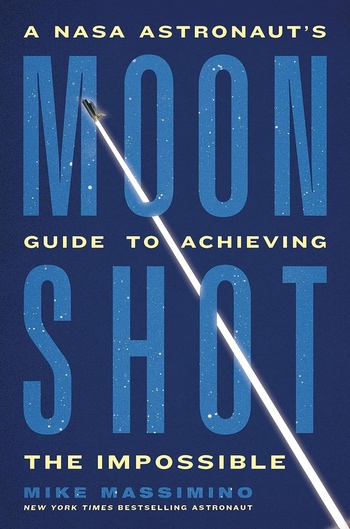 |
Review: Moonshot
by Jeff Foust
Monday, December 18, 2023
Moonshot: A NASA Astronaut’s Guide to Achieving the Impossible
by Mike Massimino
Hachette Go, 2023
hardcover, 224 pp.
ISBN 978-0-306-83264-2
US$28
To the general public, astronauts can seem like the closest thing to perfect people. They are physically fit individuals with backgrounds ranging from science and engineering to being military test pilots, with NASA picking a handful of the very best out of an applicant pool of more than 10,000 for each class. But astronauts, of course, are people that make mistakes like the rest of us, from misplacing tomatoes being harvested on the International Space Station for eight months to losing a tool bag on a recent space station spacewalk.
There are lessons to learn from such mistakes beyond keeping better track of tomatoes and tool bags. In Moonshot, former NASA astronaut Mike Massimino distills his experiences at NASA into a set of lessons for the public, a hybrid of astronaut memoir (which he has previously written) and self-improvement book.
| A fellow astronaut took him aside and informed him of “Hoot’s Law,” named after astronaut Hoot Gibson: “No matter how bad things may seem, you can always make it worse.” |
Massimino has crafted a persona as something close to an ordinary person: an everyman from Long Island, albeit one with an engineering PhD from MIT who went to space twice to repair the Hubble Space Telescope. “I soon found that what made my experiences relatable was the fact that I wasn’t a natural. I’m not Neil Armstrong. Or Lebron James. Or George Clooney,” he writes.
In the book, he’s open about his setbacks and mistakes he made both trying to become an astronaut as well as during his astronaut career. One example he offers in the book is when, during one of his first sessions in the Neutral Buoyancy Lab, used for spacewalk training, he got tangled in a safety tether and, rather than ask for help, tried to free himself, only to get further entangled. Afterwards, he said a fellow astronaut took him aside and informed him of “Hoot’s Law,” named after astronaut Hoot Gibson: “No matter how bad things may seem, you can always make it worse.”
Not making things worse is one of the lessons that Massimino passes along in the book. Most of them seem straightforward and common sense: the value of teamwork and collaboration, speaking up if you see something wrong, and not giving up even in the face of long (but non-zero) odds. He also passed along what former astronaut Alan Bean called the “First Rule of Leadership,” which is to admire and care about every member of your team, as well as the “Thirty-Second Rule,” which is to allow yourself a half a minute to beat yourself up about making a mistake, then move on.
Those lessons seem straightforward, but the fact that astronauts have to be reminded of them is a sign that they’re hard to implement. They’re good lessons to learn, and Massimino offers them in an entertaining way. You may make many mistakes along the way, but there’s a good chance you’ll never lose a tomato on a space station or a tool bag on a spacewalk.
Jeff Foust (jeff@thespacereview.com) is the editor and publisher of The Space Review, and a senior staff writer with SpaceNews. He also operates the Spacetoday.net web site. Views and opinions expressed in this article are those of the author alone.
Wednesday, December 20, 2023
Monday, December 18, 2023
Sunday, December 17, 2023
Saturday, December 16, 2023
Wednesday, December 13, 2023
Monday, December 11, 2023
US and Soviet Manned Spacecraft That Never Flew
Diamonds and DORIANS: The Soviet Union’s Almaz and the United States’ Manned Orbiting Laboratory military space stations (part 1)
by Bart Hendrickx and Dwayne A. Day
Monday, December 11, 2023
In the early 1980s, inside a secure US Air Force facility known as the Blue Cube and located not far from the 101 Freeway in Silicon Valley in Northern California, there was a large photograph hanging on a wall. It was in black and white and showed an ungainly-looking spacecraft, a cylinder with solar panels and a conical nose at one end. The vehicle was launched by the Soviet Union and was known as a Transportnyi Korabl Snabzheniya, or Transport Supply Spacecraft—“TKS” for short. The photograph was top secret and had been taken by an American GAMBIT reconnaissance spacecraft, demonstrating its ability to photograph other spacecraft in orbit. The TKS was designed to carry a crew and supplies to a secretive Soviet space station known as Almaz (“diamond”), which itself was equipped with a powerful camera system—and a 23-millimeter cannon that could have blown the GAMBIT out of the sky if it had ever gotten too close. The Cold War was also waged in orbit.
| Both Almaz and MOL failed to demonstrate a viable military role for humans in Earth orbit. |
Almaz was a product of the design bureau led by Vladimir Chelomei, originally called OKB-52 and later renamed TsKBM (1966) and NPO Mashinostroyeniya (1983), the name it still holds today. In many ways, it was a competitor of the OKB-1 design bureau of the famous chief designer Sergei Korolev, which later evolved into what is now known as RKK Energiya. Three Almaz stations were launched under the cover names Salyut-2, Salyut-3, and Salyut-5 in 1973, 1974, and 1976 respectively, creating the impression that they were of the same type as the civilian Salyut stations of Korolev’s design bureau. As would become known much later, the civilian stations (internally designated “Longterm Orbital Station” or DOS) had not been approved until 1970 and were in fact modified versions of Almaz, which traces back its origins to 1964.
While Salyut-2 failed in orbit shortly after launch, Salyuts-3 and 5 hosted a total of three crews, which flew to the stations on Soyuz spacecraft of the Korolev bureau. Chelomei’s own TKS, a 20-ton vehicle about the same size as Almaz itself, ultimately flew only to the civilian Salyut stations and was the forerunner of later space station modules, including the Nauka Multipurpose Laboratory Module, launched to the International Space Station in July 2021.
Although Western observers were aware of the dual nature of the Salyut space stations as early as the 1970s, details about the design and history of Almaz did not begin to emerge from Russian sources until after the collapse of the Soviet Union. This made it possible to obtain a fairly good understanding of the project by the turn of the century.
Our knowledge of the project was significantly expanded with the publication in 2015 of an encyclopedia on Soviet/Russian piloted space projects, which devoted about 70 pages to Almaz. What may be the definitive history of Almaz was written by a team of authors of NPO Mashinostroyeniya and published in 2019. Titled Ogranka Almazov (“The Cutting of Diamonds”), the 500-page book contains a wealth of new information on the project and is lavishly illustrated with never-before-seen pictures and drawings taken from the company’s archives. It does relate the project’s history from the biased perspective of the organization that ran it and does not contain any primary government documents (such as government decrees and ministry orders) that would provide an even deeper insight into Almaz’s objectives, capabilities, and development.
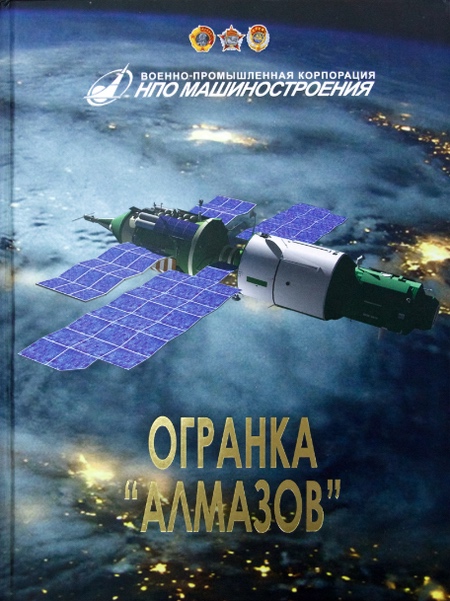 Cover of the book Ogranka Almazov. |
Almaz was the Soviet counterpart to America’s Manned Orbiting Laboratory (MOL). Both were designed as piloted reconnaissance platforms, but unlike Almaz, MOL was canceled in 1969 before a single mission was flown. The National Reconnaissance Office, which was developing the MOL in the 1960s, finally declassified the program in 2015, releasing an official history along with thousands of pages of documents. The NRO later followed this with a history featuring many interviews with the surviving MOL astronauts.
With many aspects of MOL and Almaz now declassified, it has become possible to make a comparison of their objectives, design features, and the reasons for their cancelation. Both Almaz and MOL failed to demonstrate a viable military role for humans in Earth orbit.
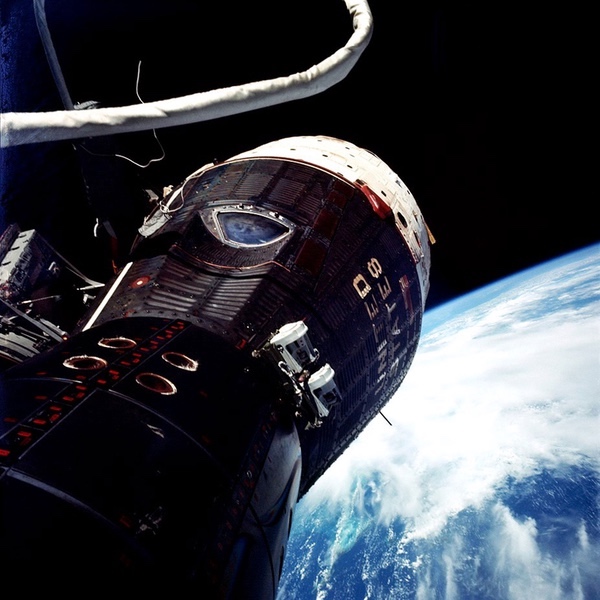 NASA's Gemini spacecraft offered an opportunity for the U.S. Air Force to take advantage of the civilian space agency's investment in a spacecraft that could be adapted for military missions. (credit: NASA) |
Origins and objectives: the US story
Early manned military space projects
The idea of military astronauts operating in space predates the space age by decades. Science fiction stories often depicted space travelers as members of the military, and both the Soviet and American space programs, even while pursuing civil space goals, recruited from military ranks. But it was not obvious even by the early 1960s when astronauts and cosmonauts were orbiting the Earth that there were military space missions that required military astronauts.
The United States Air Force had several programs underway in the early 1960s that were intended to pursue military goals, but their fates highlighted the dilemma of the role of military astronauts.
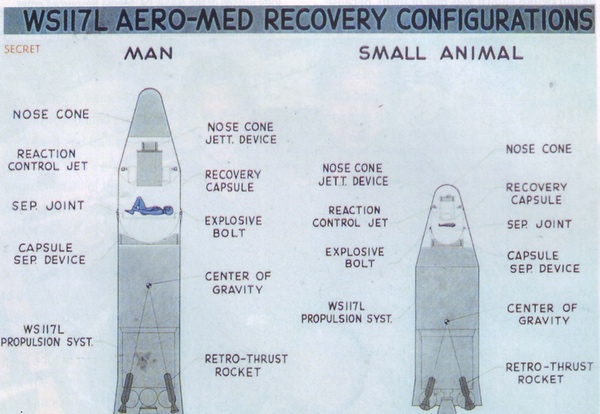 When NASA was created in 1958, the civilian agency was given responsibility for developing human spaceflight, with the U.S. Air Force allowed to investigate any military role for astronauts in orbit. During the late 1950s and early 1960s, the Air Force continued to study its own capsule-type spacecraft, and began development of the pressurized Samos E-5 reconnaissance satellite which could potentially be converted into a manned spacecraft. (credit: NRO) |
The least known and still most mysterious of the military human spaceflight projects was the Samos E-5, which appears to have been initiated by the US Air Force when the service was forbidden from having an astronaut program competing with NASA’s Mercury program. Samos E-5 was a pressurized capsule equipped with a camera system for photographing the Earth. At the end of its mission, the entire spacecraft would return to Earth. The concept was similar to the Soviet Vostok, which also had a camera-carrying variant. At the time, other American reconnaissance spacecraft were not pressurized and did not return their cameras. There are no surviving records directly stating that the Air Force intended to convert the E-5 spacecraft to carry an astronaut, although a declassified official history as well as at least one contemporaneous CIA document both indicate that this was what the Air Force sought to do. Five Samos E-5 spacecraft were launched in 1962, but all failed and the program was canceled.
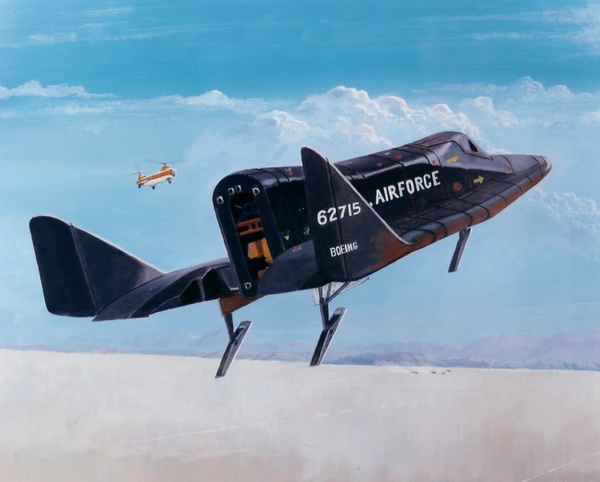 The X-20 Dyna-Soar program was intended to develop a piloted winged spacecraft for the Air Force. Various missions and payloads were proposed for the small spaceplane. The high cost and lack of a clear mission led to its cancellation in late 1963. (credit: USAF) |
The Blue Gemini program was created in 1962 as a limited series of missions that would give the Air Force experience with flying astronauts in space. It grew out of existing NASA and Air Force cooperation on NASA’s Gemini program, which used an Air Force-supplied Titan II rocket. The Blue Gemini proposal was to initially fly joint missions with NASA astronauts on board, then to transition to all-military crews, and possibly to fly one or two missions with a single astronaut and the empty seat occupied by military equipment. But it was unclear exactly what the military astronauts would do other than fly in orbit. The Air Force identified no unique military missions that required a military pilot to perform. Small experiments or military sensors could more easily and cheaply be accommodated on robotic spacecraft. Blue Gemini was canceled the same year that it started. Some Air Force experiments considered for Blue Gemini were transferred to NASA’s Gemini program. Air Force close cooperation with NASA on Gemini provided the service with access to NASA’s experience (see: “A darker shade of blue: The unknown Air Force manned space program,” The Space Review, September 12, 2022.)
| MOL was justified as a project whereby military astronauts would conduct experiments in orbit to determine the utility of astronauts to perform military missions. But at this point, MOL was not really defined. |
The X-20 Dyna Soar spaceplane was canceled in 1963 after numerous proposed operational uses like dropping weapons, attacking other spacecraft, and performing reconnaissance, were considered and rejected, and the experimental mission of demonstrating a winged reentry vehicle could not justify its cost. The Air Force had also been evaluating military Moon bases and a Military Operational Development Station (MODS) in Earth orbit from the late 1950s into the early 1960s, but the MODS name indicated the problem: there were no obvious military missions that required astronauts in space, and they had to be evaluated and developed.
In late 1963, after the cancellation of Dyna Soar, the Air Force began the Manned Orbiting Laboratory program.
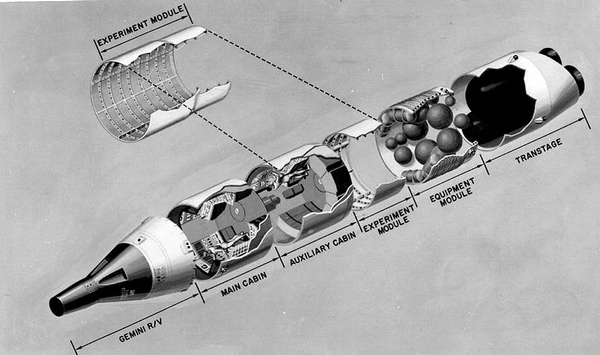 Early concepts for the Manned Orbiting Laboratory implied that it was to perform mostly unclassified research and development missions. But during 1964, the National Reconnaissance Office was sponsoring a series of studies about using MOL to carry powerful optics and perform an operational intelligence collection mission. (credit: NRO) |
Early MOL
In December 1963, the Department of Defense announced the Manned Orbiting Laboratory program. MOL was justified as a project whereby military astronauts would conduct experiments in orbit to determine the utility of astronauts to perform military missions. But at this point, MOL was not really defined. The Air Force began studying several possible military missions that MOL could conduct. These included serving as a command-and-control center, hosting multispectral sensors, and enabling manned assembly of large structures such as antennas. These missions and others were studied throughout 1964, but none of them seemed to coalesce into a clear justification for the orbiting laboratory. Various unclassified artwork of the MOL was produced at this time, and because that artwork became public and was regularly republished, it created a popular impression that MOL was primarily a large pressurized laboratory in which the astronauts worked, rather than what it later became, which was a much smaller pressurized compartment attached to a large unpressurized “mission compartment” containing an optical system.
This phase of endless studies proved frustrating for those in the MOL program office. As one officer explained to another, they had spent most of 1964 trying to move the program “off dead center.”
Around the same time that MOL had been publicly announced, the Director of the National Reconnaissance Office ordered a study of man’s contribution to satellite reconnaissance. This led to an industry survey of manned reconnaissance systems that could fit in a Titan IIIC rocket and studies at Eastman-Kodak from December 1963 to July 1964 of manned reconnaissance systems. In summer 1964, those studies were refined and led to studies of optical systems that could be incorporated into a MOL-sized vehicle. Those “optical system configuration studies” continued into early 1965.
In spring 1964, the NRO created the DORIAN security compartment within the BYEMAN security control system. Only persons with BYEMAN security clearances were allowed to know about reconnaissance systems. DORIAN was a compartment devoted to the study and development of a large optical system for MOL.
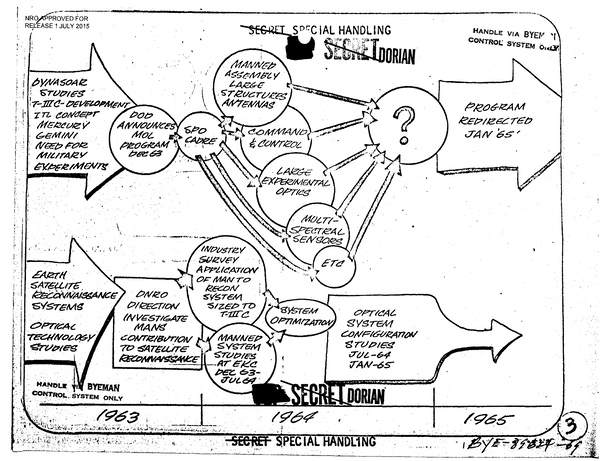 Throughout 1964, various possible military missions were studied for the Manned Orbiting Laboratory, although most of them coalesced around an operational photo-reconnaissance mission. (credit: NRO) |
Later MOL
In January 1965, the MOL program was redirected. Rather than a laboratory containing multiple experiments, the goal became developing MOL into an operational reconnaissance platform that would produce intelligence to be used by national-level leadership, meaning the President, the Secretary of Defense and senior Pentagon leadership, and the Central Intelligence Agency and other relevant intelligence agencies. The optical system for MOL was named DORIAN, a name that was never to be spoken or transmitted outside of secure facilities. After the MOL program was declassified, one MOL astronaut remembered that the general in charge of the program had a female secretary named “Dorian,” and the astronaut used to flinch whenever the general would yell for her to come into his office.
Although MOL retained its “laboratory” name, by 1965 MOL was intended to support a large optical system that astronauts would use to photograph the Soviet Union at high resolution. The United States already operated robotic reconnaissance satellites, but MOL was intended both to take photographs at higher resolution than any of them and to avoid their deficiencies. It was assumed that astronauts could improve image focus and operations, fix malfunctions, and photograph “targets of opportunity” including finding gaps in cloud cover over reconnaissance targets such as Moscow. A major justification for including astronauts in MOL was that the small field of view of the powerful optical system required an astronaut to accurately point it at the targets. Another justification, soon abandoned, was that astronauts were needed to assure the reliability of the electronic systems on the spacecraft. But rapidly improving electronic systems soon made this unnecessary.
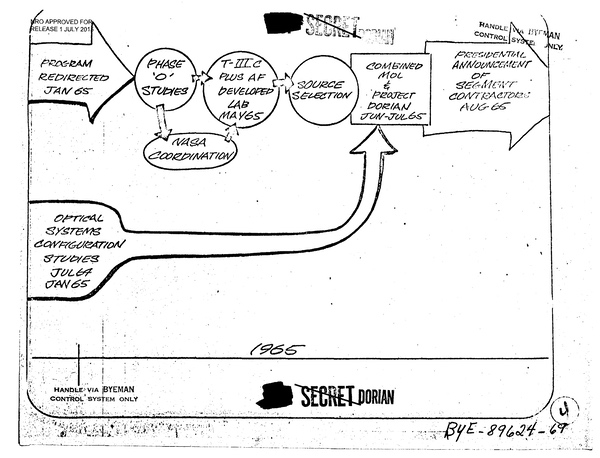 Throughout the first half of 1965, MOL became better defined as an operational reconnaissance satellite, leading to eventual presidential authorization of the program in August. (credit: NRO) |
NRO reconnaissance satellites had been plagued by clouds early in their operations, with some missions returning photographs that were 50% cloud cover. But by the early 1960s the NRO began operating its own series of meteorological satellites to determine cloud cover over Soviet targets before the film satellites made their passes over those targets. The meteorological satellites could provide data to enable ground controllers to command the satellites to not take photos. The MOL DORIAN system would have such a small field of view that a human operator could be useful for avoiding small patches of clouds, but this requirement indicated an inherent dilemma for MOL: the value of the astronauts was very limited and specific.
Although MOL evolved throughout 1964 and into 1965, it was not until August 1965 that the program received presidential approval, a key factor in obtaining budgeting for full-scale development. The publicly released estimate was that MOL would cost $1.5 billion. At that point, MOL transitioned from “Pre-Phase I” to “Phase I”—the phase where MOL would start getting expensive.
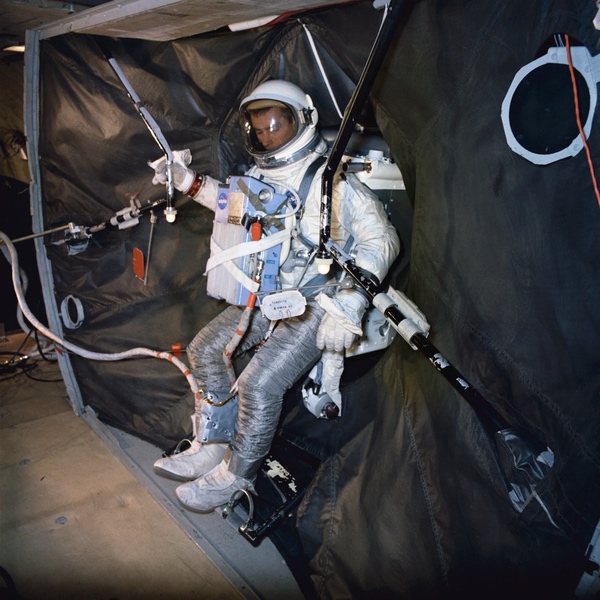 The Astronaut Mobility Unit was originally an Air Force project but was transferred to NASA for testing, indicating one of the dilemmas for any military space program--much research and development could be handled by the civilian space agency. The AMU was flown on a Gemini mission, but was unable to be tested. (credit: NASA) |
Part of the problem for manned military space programs in the United States was that NASA already existed, was active, highly public, and well-funded. This had practical and ideological effects. With NASA performing many different experiments and missions involving astronauts, there were fewer activities for military astronauts to perform, and many opportunities to shift the work to NASA. Between March 1965 and November 1966—a period of 20 months—NASA launched ten Gemini missions. The agency gained significant experience within a short period of time and developed hardware with each mission. Gemini 9, for instance, launched in June 1966 and included the Air Force’s Astronaut Maneuvering Unit. Although the AMU was not able to be tested on this mission, it demonstrated that if NASA could perform a test flight, the military did not have to. This also created political pressure as well. At one point during the MOL program, the Air Force faced uncomfortable questions from Congress about why they needed to launch from California when there were already existing facilities in Florida. Military astronaut programs had a harder time justifying their existence in an openly public and political environment.
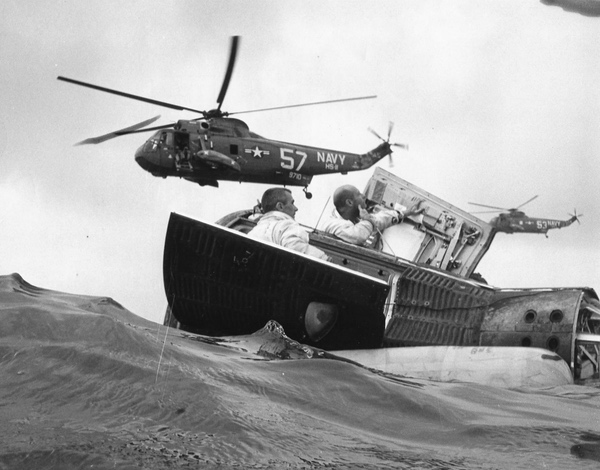 NASA flew ten Gemini missions within a very short period of time, developing new technology and operational concepts that the Air Force could take advantage of. Here the Gemini 9 crew is being recovered after their mission. (credit: US Navy) |
After presidential approval, the MOL program started contract definition from October 1965 to May 1966. Proposal evaluations took place from June to September 1966. Contract negotiations occurred from July to December 1966. But in January 1967 it became apparent that the funding needs exceeded the budget, prompting a schedule adjustment. By mid-1967, the program had direction to proceed on a new schedule and baseline allocation of funds for fiscal year 1968, which started in July 1967. (At the time, the US government's fiscal year ran from July to June. Later it would start on October 1.)
Douglas Aircraft Company was the prime contractor for the laboratory. Eastman-Kodak was the contractor for the powerful DORIAN optical system (the contract was secret.) McDonnell Aircraft Corporation was the prime contractor for the Gemini B spacecraft. General Electric was responsible for major subsystems. Many of the major contractors built substantial new infrastructure to support MOL. Douglas built a new building in California for major structural assembly of the laboratory. Eastman-Kodak built a large building in Rochester, New York, with new fabrication and testing equipment to handle the big optical systems.
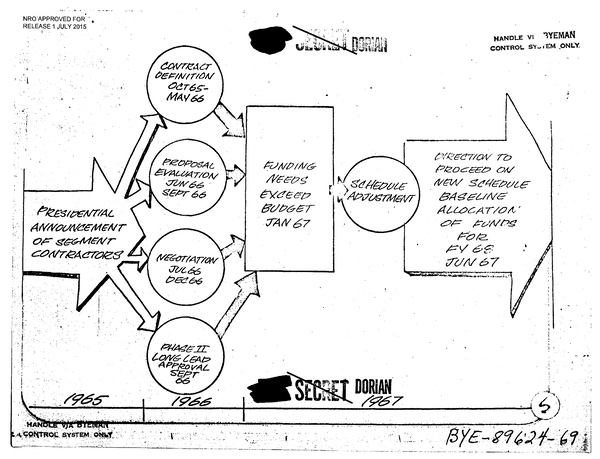 Once MOL received high-level approval, the Air Force and National Reconnaissance Office began issuing contracts with aerospace companies to develop MOL hardware. But it quickly became apparent that the program’s costs were much higher than initially planned and the program’s schedule had to be adjusted. (credit: NRO) |
Douglas selected four major subcontractors: Hamilton-Standard for environmental control and life support, Collins Radio for communications, Honeywell for attitude control, and Pratt & Whitney for electrical power. Although Douglas selected IBM for data management, the Air Force objected based upon their high cost compared to UNIVAC, and Douglas therefore signed study contracts with both firms. The Aerospace Corporation was given responsibility for general systems engineering and technical direction, a role that it played for many Air Force missile and space programs.
| The optical system for MOL was named DORIAN, a name that was never to be spoken or transmitted outside of secure facilities. After the MOL program was declassified, one MOL astronaut remembered that the general in charge of the program had a female secretary named “Dorian,” and the astronaut used to flinch whenever the general would yell for her to come into his office. |
The MOL would be launched on top of a powerful new booster designated the Titan IIIM. It would require a new launch pad at Vandenberg Air Force Base in California. Using eminent domain, the government seized property to the south of the existing base from the wealthy Sudden family, which owned farm and ranching lands along significant portions of the California coast. The Air Force then began construction of Space Launch Complex-6 on the property. The land seizure resulted in a lawsuit by the Sudden family and the Air Force was later forced to pay more for the seized property than it initially proffered.
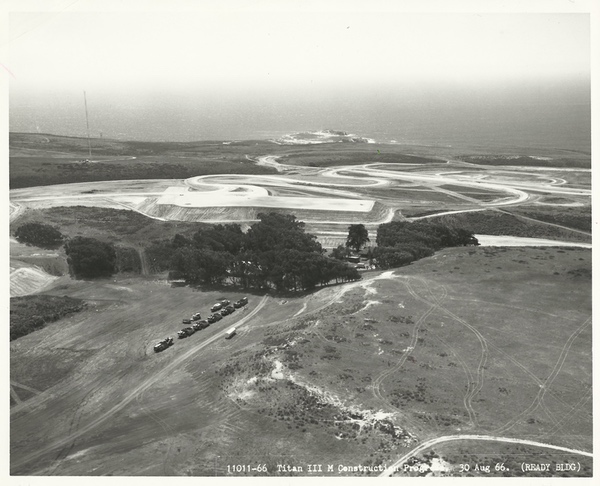 At Vandenberg Air Force Base on California's central coast, a large area known as Sudden Ranch was seized from the Sudden Family using eminent domain. This area was needed for construction of the MOL launch pad, known as Space Launch Complex-6. The Sudden Family challenged the seizure in court, claiming that the government underpaid for the land, and was awarded additional money. (credit: Joe Page) |
Space Launch Complex-6, also known as SLC-6 or “Slick Six,” required the clearing and preparation of a substantial amount of area nestled between low mountains and the coast. After the area was cleared, a concrete foundation and flame ducts were constructed, and the launch and support structures were started.
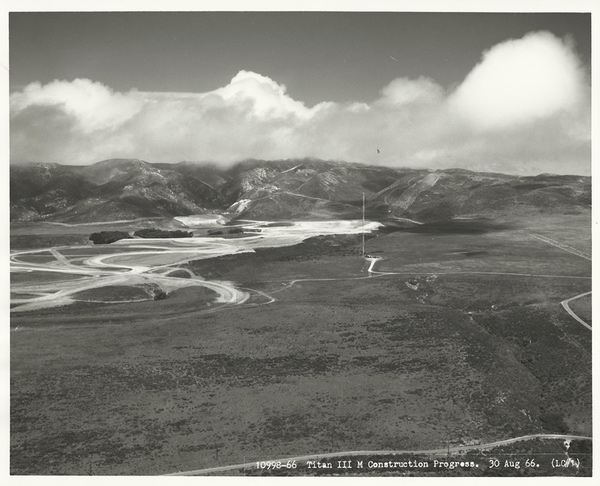 Space Launch Complex-6 was one of the largest construction projects at Vandenberg. The complex had to support both the Titan IIIM rocket--the most powerful planned for Vandenberg—as well as the MOL and Gemini payloads and astronaut activities. (credit: Joe Page) |
Astronaut selection
While the MOL program started selecting contractors, signing contracts, and beginning the early stages of program development, the Air Force also selected its first group of MOL astronauts and announced them on November 12, 1965. Two more MOL astronaut groups were selected, in June 1966 and June 1967. Once they were selected for the program, the MOL astronauts were immediately briefed on its mission, as well as shown the results of other space intelligence programs. For most of them, this was their first exposure to a highly classified world of space-based reconnaissance that they were completely unfamiliar with.
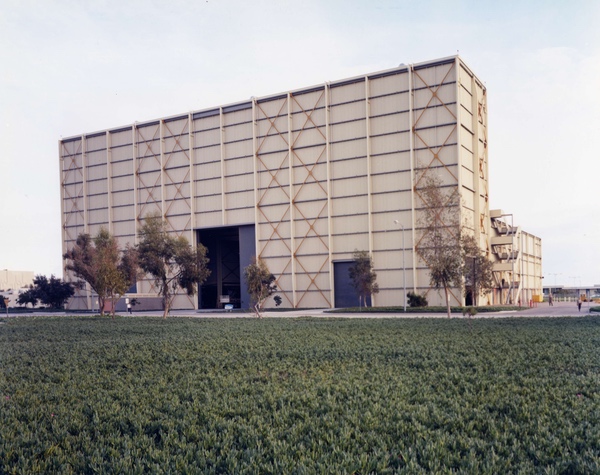 The Manned Orbiting Laboratory program required the construction of substantial new infrastructure, such as this processing building for Douglas in California. (credit: NRO) |
Origins and objectives: the Soviet story
Early manned military space projects
The Soviet space program lacked the clear dichotomy between civilian and military space projects that existed in the United States after the formation of NASA in 1958. As a result, the piloted and military space programs were closely intertwined from the very beginning. Vostok, the country’s first crewed spacecraft (built by Sergei Korolev’s OKB-1 bureau), was in fact a piloted version of an identically named automatic reconnaissance satellite, which was renamed Zenit after the name Vostok became public knowledge with the launch of Yuri Gagarin in April 1961. Tellingly, the government decree that sanctioned Vostok in May 1959 mentioned the piloted aspect of the project only in its supplements. As has become clear from declassified documents in recent years, an important initial objective of the crewed Vostok project was to demonstrate the value of having military persons in orbit, although none of the missions that were eventually flown had any unambiguous military objectives.
Like the United States, the Soviet Union studied piloted spaceplanes that would be used for missions such as satellite inspection and negation. That work continued even after the cancelation of Dyna-Soar in 1963. An air-launched spaceplane called Spiral was approved in 1966 and reached the stage of atmospheric drop tests in the 1970s before it was superseded by Buran, the counterpart to America’s Space Shuttle. Even Buran itself was primarily seen as a response to the perceived military threat posed by the Space Shuttle. (See “Target Moscow: Soviet suspicions about the military uses of the American Space Shuttle (part 1)” The Space Review, January 27, 2020; and “Target Moscow: Soviet suspicions about the military uses of the American Space Shuttle (part 2)” The Space Review, February 3, 2020.)
At Korolev’s OKB-1 bureau, plans for dedicated military piloted spacecraft emerged in 1962–1963 as part of the Soyuz project, which at the time was aimed at assembling spacecraft in Earth orbit for a wide variety of purposes. Two vehicles that appeared on the drawing boards were 7K-P for satellite inspection and 7K-R for reconnaissance (7K was the industry designator for Soyuz.) The work was soon transferred to OKB-1’s Branch number 3 in Kuibyshev (now called Samara), headed by Dmitri Kozlov. This had already taken over the production and further design of the Zenit spy satellites from OKB-1’s central bureau and would go on to hold a virtual monopoly in the field of optical reconnaissance satellites (it is now known as the Progress Rocket and Space Center.)
One audacious plan for the 7K-P missions was for one of the crew members to perform a spacewalk to the enemy satellite and attach explosives to it. Another version of the spacecraft, named 7K-PPK, would be equipped with eight space-to-space missiles to knock out enemy targets. However, plans for manned ASAT platforms were not long-lived as attention turned to doing the same job with unmanned interceptors.
| One audacious plan for the 7K-P missions was for one of the crew members to perform a spacewalk to the enemy satellite and attach explosives to it. |
By 1965 the only surviving project was the reconnaissance vehicle (7K-R or Soyuz-R), essentially a small Soyuz-based space station that would be visited by Soyuz spacecraft. Later that year it morphed into 7K-VI (“VI” standing for voyenno-issledovatelskiy, meaning “military research”). Also known as Zvezda (“Star”), this was designed to carry two cosmonauts on one-month missions. By early 1967, it had significantly evolved from the basic Soyuz design, with the reentry capsule mounted on top of a cylindrically shaped work compartment, making it look somewhat like a small version of MOL. Like MOL, it would have been launched with the crew on board and cosmonauts would have entered the work compartment via a hatch in the heat shield. On-board systems would draw power from radioisotope generators rather than solar panels. In contrast to Almaz, very little is known about 7K-VI. Almost all the available information on it stems from a series of articles published in the Russian space magazine Novosti Kosmonavtiki in 1997.
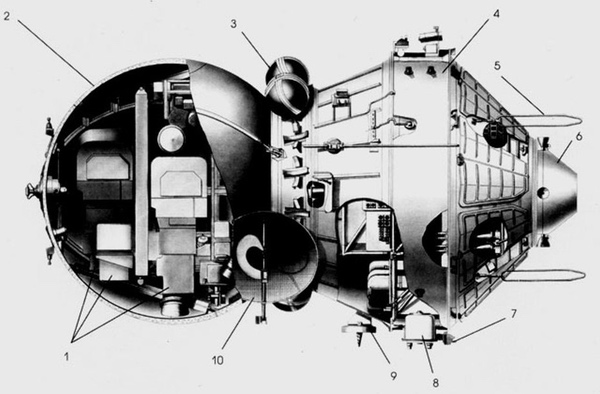 The Vostok look-alike Zenit-2 reconnaissance satellite. (credit: RKK Energiya) |
The origins and objectives of Almaz
The initiative to develop a much larger military space station came from the OKB-52 design bureau of Vladimir Chelomei. Having initially specialized in anti-ship cruise missiles, it branched out into intercontinental ballistic missiles, space launch vehicles, and military satellites in the late 1950s and early 1960s. Among the projects it worked on were the UR-500/Proton rocket (originally conceived as an ICBM), ocean reconnaissance and early warning satellites, as well as anti-satellite systems.
The roots of Almaz go back to 1964, but even the new publications on Almaz remain vague on its origins. Like earlier sources, they trace back the start of the project to October 12, 1964, when Chelomei convened a meeting at his design bureau to announce the goal of building a big 20-ton piloted reconnaissance platform to be launched by his design bureau’s powerful Proton rocket, a two-stage version of which would make its debut in July 1965 (Almaz required a three-stage version.) Obviously, Chelomei did not come up with the idea overnight, but nobody seems to know or remember what had led him to make this proposal or even if Almaz was his own brainchild. It is tempting to believe that Chelomei’s main source of inspiration had been MOL, but there is no hard evidence to back up that claim. The 2019 history of Almaz does reveal that by early 1966, both 7K-VI and Almaz had been included in “a five-year plan for the development of space systems.” This was possibly a reference to a five-year plan for space-based reconnaissance systems known to have been signed by Minister of Defense Rodion Malinovski on June 18, 1964.
Even though Almaz may have been high on Chelomei’s wish list, the project’s final approval was far from a done deal. Just two days after the October meeting, Soviet leader Nikita Khrushchev was overthrown and replaced by Leonid Brezhnev. Khrushchev had been a strong supporter of Chelomei, at least in part because his own son (Sergei Khrushchev) worked for the design bureau. With Khrushchev gone, Chelomei found himself fighting for the survival of many of his space and missile projects. In October 1965, the Ministry of General Machine Building, set up in March 1965 to co-ordinate Soviet space and missile projects, did allow OKB-52 to work out a preliminary design for both Almaz (then simply called Orbital Piloted Station or OPS) as well as a piloted “inspector/interceptor” vehicle (abbreviated PP), probably an outgrowth of a military spaceplane (Raketoplan) that the bureau had earlier worked on.
OPS was high on the agenda during a critical meeting at the Ministry of General Machine Building in January 1966. Various accounts have been given of this meeting, but according to the 2019 Almaz history, its main purpose was to decide who would build OPS. Some were in favor of relegating OKB-52’s role in the space program to testing hardware developed by other design bureaus and assigning both 7K-VI and Almaz to OKB-1’s Branch nr. 3, meaning that the preliminary design of Almaz that had already appeared by that time was not yet set in stone. Chelomei reportedly fended off the attacks against his design bureau by saying that a quick response was needed to America’s MOL and that the already overtaxed OKB-1 would be hardly capable of coping with that task. This is the only known reference that Chelomei ever made to MOL.
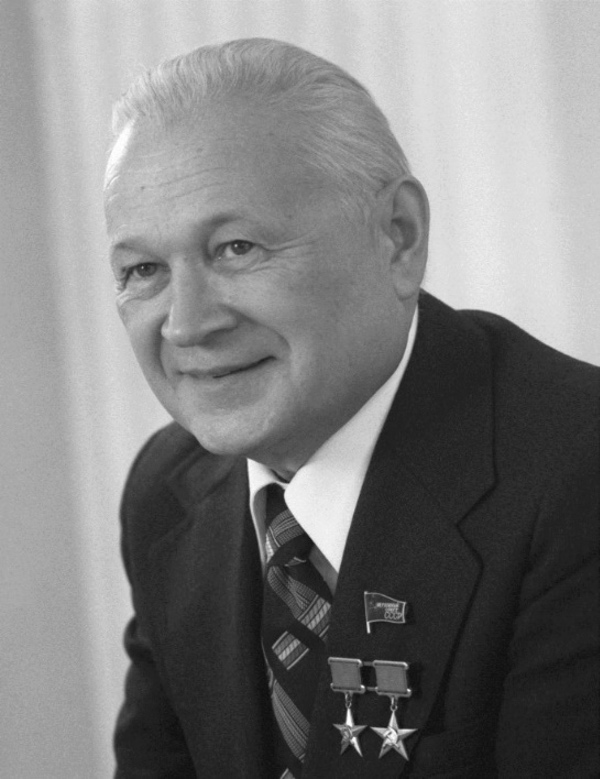 Vladimir Chelomei |
The consensus reached at the meeting was that Almaz should be developed by Chelomei’s bureau, but that OKB-1 Branch nr. 3 would have to design a transport vehicle for the station derived from 7K-VI. This decision was consolidated by a Communist Party and government decree of July 21, 1966, which officially named Chelomei’s bureau as the prime contractor for Almaz and opened up funding for the project. This can be considered the real start date of the project, nearly one year after MOL received presidential approval.
The available information suggests that 7K-VI and Almaz were not competitors, but two projects that had their own well-defined goals and were both considered worth carrying out. One piece of evidence pointing in that direction is the fact that two separate teams of cosmonauts trained for the two projects simultaneously. Russian sources have shed little light on the motives for having two different piloted military space systems. What is obvious, though, is that the Soyuz-based vehicle (weighing just under seven tons) had much more limited capabilities than the 20-ton Almaz. As the name “VI” itself implies, it seems to have been intended mainly for military research, whereas Almaz was seen as an operational reconnaissance platform. In a way, 7K-VI would perform the research role that was originally envisaged for MOL, while Almaz would do the operational reconnaissance work that became the ultimate goal of MOL.
Little has been revealed about the kind of work that would be done aboard 7K-VI. Cosmonauts would have used an optical visor to look for interesting targets and subsequently photographed them with an onboard camera. One experiment known to have been prepared for 7K-VI had the name Svinets (“lead”) and was aimed at observing Soviet missile launches with an experimental infrared detector that could later be modified for installation aboard early warning satellites (the experiment was eventually performed by the crew of Soyuz-6 in 1969.) 7K-VI also had a limited electronic intelligence capability and would have carried equipment to defend it from ASAT attacks.
As has become clear from the newly published information, Almaz was initially conceived as a versatile reconnaissance platform that would carry not only optical instruments, but also radar, infrared, and signals intelligence payloads. As stipulated in the June 1966 decree, Almaz was to conduct “detailed all-round reconnaissance of particularly important small-size and partially concealed strategic objects with a resolution of 0.5 to 1.0 m” during missions lasting one to two years.
Among the objects of interest were launch sites of ICBMs and space launch vehicles, airfields for strategic bombers, naval bases, anti-missile and counterspace detection and targeting systems, communication facilities, military-industrial installations, and storage facilities. Also included in the objectives were “the study of methods for the military use of space assets during long-duration missions of up to six months” as well as biomedical research (presumably linked to the long-duration missions.) This indicates that Almaz also had non-military goals, which may be explained by the fact that there were no serious plans at the time for civilian space stations. Since OKB-1 was preoccupied with Voskhod, Soyuz, and the piloted lunar program, its space station work had remained limited to paper studies, making it easier for OKB-52 to fill the space station niche.
| In short, Almaz could do the same job as a whole bunch of military satellites taken together. In addition to all that, the cosmonauts could also do repair and maintenance work if required. |
Almaz was expected to vastly expand the capabilities offered by Soviet military satellites in the 1960s. The Vostok look-alike Zenit reconnaissance satellites carried traditional refractor (glass lens) camera systems with limited focal lengths. Moreover, they could stay in orbit for only one to two weeks, requiring a massive number of launches to provide continuous coverage of critical areas. None of the pictures could be sent back to Earth in real time, meaning that critical imagery would take days to reach photo interpreters. On top of that, many of the pictures returned by the satellites showed only cloud cover, rendering them useless. Unlike the United States, the Soviet Union did not have dedicated military weather satellites to help the reconnaissance satellites obtain cloud-free pictures.
Almaz could address all of these problems. Its sheer size enabled it to carry large catadioptric imaging systems (using both lenses and mirrors) with long focal lengths that did not fit inside the crammed Zenit descent capsule and would offer a resolution of one meter or better. Unlike Zenit, a single Almaz could stay in orbit for weeks or months and imagery could regularly be sent to the ground in film return capsules or sent back to Earth (at lower resolution) in real time using a photo readout system. Cosmonauts could look for interesting targets and spot cloud cover in advance to make sure that no precious film was wasted while flying over these regions. If necessary, the on-board infrared and radar systems could be used to peer through the clouds. In short, Almaz could do the same job as a whole bunch of military satellites taken together. In addition to all that, the cosmonauts could also do repair and maintenance work if required. The presence of cosmonauts not only increased the flexibility of the station but was simply necessary because all these operations could hardly be automated with the technology available in the 1960s.
Kozlov’s 7K-VI project seems to have survived until early 1968, but the reasons for its cancelation remain vague. Judging from the diaries of cosmonaut training chief General Nikolai Kamanin, there was much opposition against it from Vasili Mishin, who had succeeded Sergei Korolev after the latter’s death in January 1966. Instead of 7K-VI, Mishin proposed a small Soyuz-based space station (Soyuz-VI) that harked back to the 1963 Soyuz-R design, but that was abandoned as well in 1970 after the approval of the civilian Salyut space stations. A crew ferry that was designed for Soyuz-VI did later evolve into the three-man Soyuz-T spacecraft, which flew 15 missions to Salyut-6, Salyut-7, and Mir in 1980–1986.
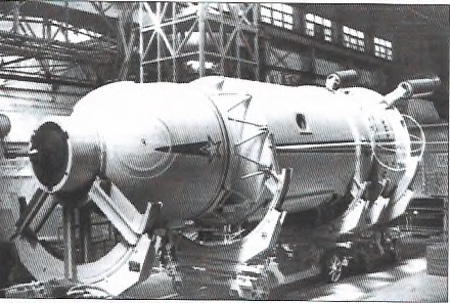 Mockup of the 7K-VI Zvezda spacecraft. (credit: Novosti Kosmonavtiki) |
Cosmonaut selection
Cosmonaut teams for both 7K-VI/Zvezda and Almaz were selected in September 1966. The Almaz team initially consisted of just five members, headed by Voskhod-2 veteran Pavel Belyayev, but was gradually expanded during the following years. After the definitive cancelation of Soyuz-VI, trainees for that project were transferred to the Almaz group in August 1970. By 1971 the Almaz cosmonaut team, now led by Vostok-4 veteran Pavel Popovich, numbered 28 members, making it the largest training group in the Soviet cosmonaut corps at the time. The expectation was that once the project reached operational status, several Almaz stations would orbit the Earth simultaneously, requiring a large pool of cosmonauts to draw from. Ultimately, only six cosmonauts of the Almaz team would go on to fly aboard the stations.
Next: MOL and Almaz enter active development.
Bart Hendrickx is a longtime observer of the Russian space program. Dwayne Day can be reached at zirconic1@cox.net.